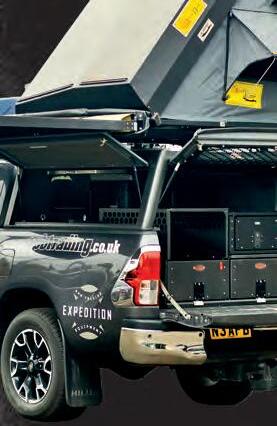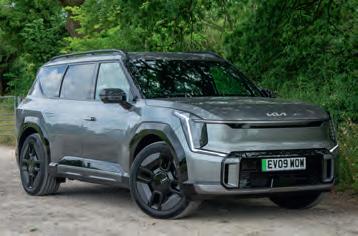
DRIVEN KIA EV9: Ultra flexible six-seat EV takes practicality to the next level





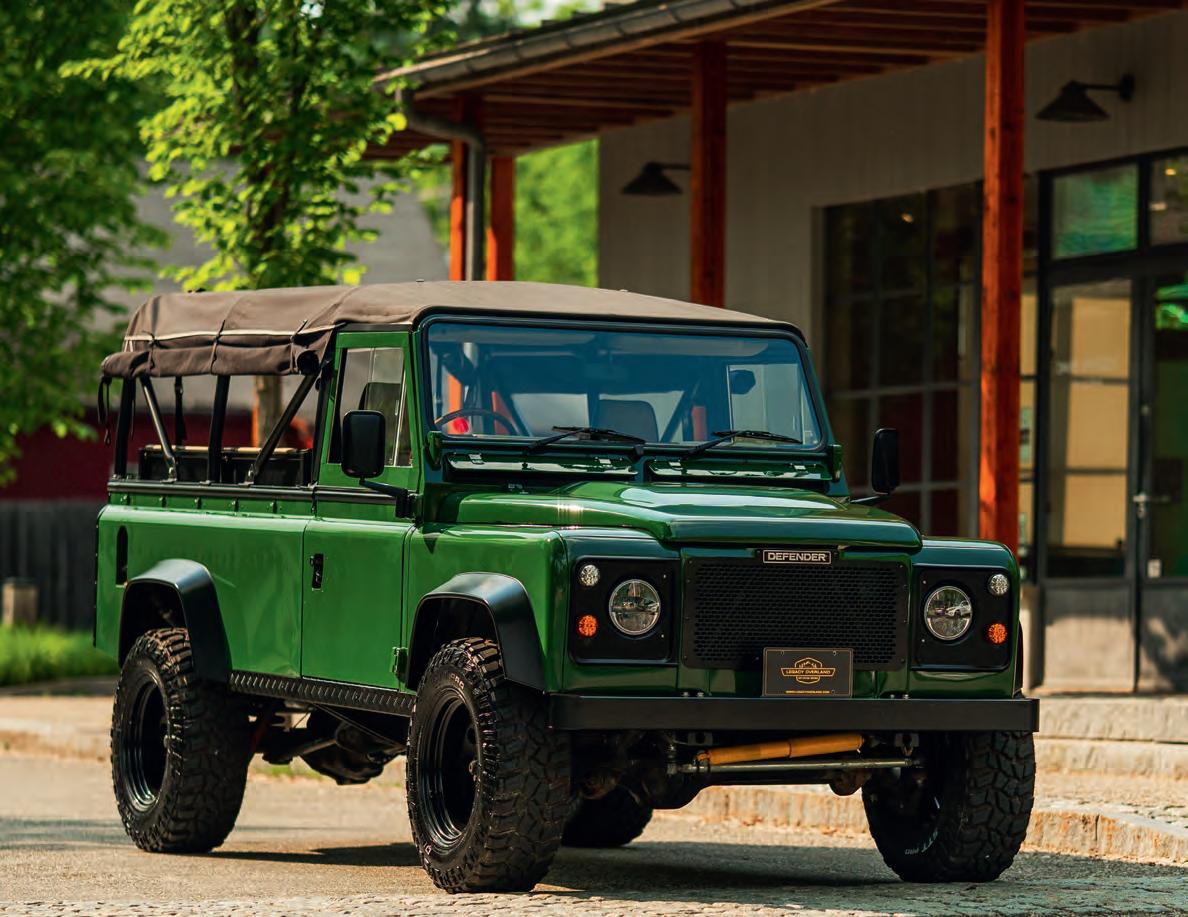
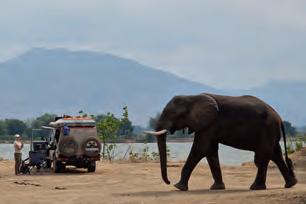
WILD WILD LIFE



DRIVEN KIA EV9: Ultra flexible six-seat EV takes practicality to the next level









Tired pre-Defender Land Rover 110 remanufactured into a beach-running pull tool with serious off-road skills





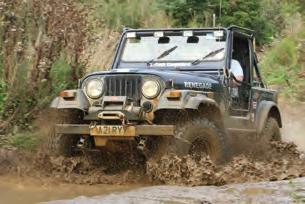

A new set of green lane routes to enjoy this autumn



































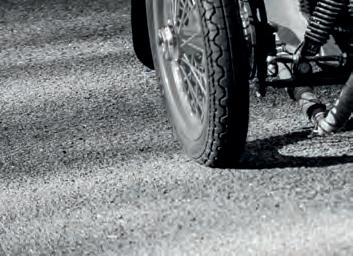





















Whether you’re embarking on an off-road expedition or packing up the kids for a summer camping trip in your Land Rover, having the right gear makes all the difference.
Prepare for your next camping adventure with high-quality, purpose-built gear that ensures a smooth and stress-free experience—wherever the road takes you!
We love seeing Terrafirma-equipped vehicles in action! Send us pictures of your off-road adventures, camping set-ups, and expedition builds for a chance to have your vehicle featured in the next Terrafirma Catalogue.
Email:
TF972 Roof Rack 2.2 x 1.0m / Steel Tubular
TF973 Rear Door Access Ladder Discovery 3 / Discovery 4
TF1714 Terradactyl 2/5 LED Awning 2.0m / 270 degrees / 5 Wing
TF1740 Portable Power Station500w Output
TF1741 Power Panel 100w / 2 section solar panel
TF1722 Camping Table 70 x 70cm / Aluminium
TF1720 Camping Chair Heavy Duty / With storage bag
TF1721 Marshal Stool Folds flat for storage
TF1211 Water Bottle 660ml / Stainless Steel
TF1212 Travel Mug 600ml / Stainless Steel
TF1213 Water Bottle CarrierInsulated / With Shoulder Strap
TF1730 Fire Pit Stainless Steel
TF1726 Expedition Shovel 1.3m handle
TF795R Dry bag 80 Litre
TF794B Dry bag 10 Litre
TF902 Expedition Storage Box 160 Litre Capacity


> Awnings & Accessories
> Expedition Essentials
> Much More...





Tel: 01283 742969
Email: enquiries@assignment-media.co.uk
Web: www.totaloffroad.co.uk www.4x4i.com
Online Shop: www.toronline.co.uk
Facebook: www.facebook.com/totaloffroad www.facebook.com/4x4Mag
Editor Alan Kidd
Design Ian Denby-Jones
Contributors
Mike Trott, Gary Martin, Olly Sack, Gary Noskill, Dan Fenn, Paul Looe, Tom Alderney, Jurij and Mateja Modic
Photographers
Steve Taylor, Richard Hair, Vic Peel, Harry Hamm
Advertising Sales
Colin Ashworth
Tel: 01283 742969 isabelle@tandemmedia.co.uk
Subscriptions Agency
WW Magazines, 151 Station Street, Burton on Trent, DE14 1BG Tel: 01283 742970
Publisher and Head of Marketing
Sarah Moss
Email: sarah.moss@assignment-media.co.uk
To subscribe to 4x4, or renew a subscription, call 01283 742970. Prices for 12 issues: UK £42 (24 issues £76); Europe Airmail/ROW Surface £54; ROW Airmail £78
Distributed by Marketforce; www.marketforce.co.uk
Every effort is made to ensure the contents of 4x4 are accurate, but Assignment Media accepts no responsibility for errors or omissions nor the consequences of actions made as a result of these. When responding to any advert in 4x4, you should make appropriate enquiries before sending money or entering into a contract. The publishers take reasonable care to ensure advertisers’ probity, but will not be liable for loss or damage incurred from responding to adverts
Where a photo credit includes the note ‘CC BY 2.0’ or similar, the image is made available under that Creative Commons licence: details at www.creativecommons.org
Overlander 4x4 is published by Assignment Media Ltd, PO Box 8632, Burton on Trent DE14 9PR © Assignment Media Ltd, 2025
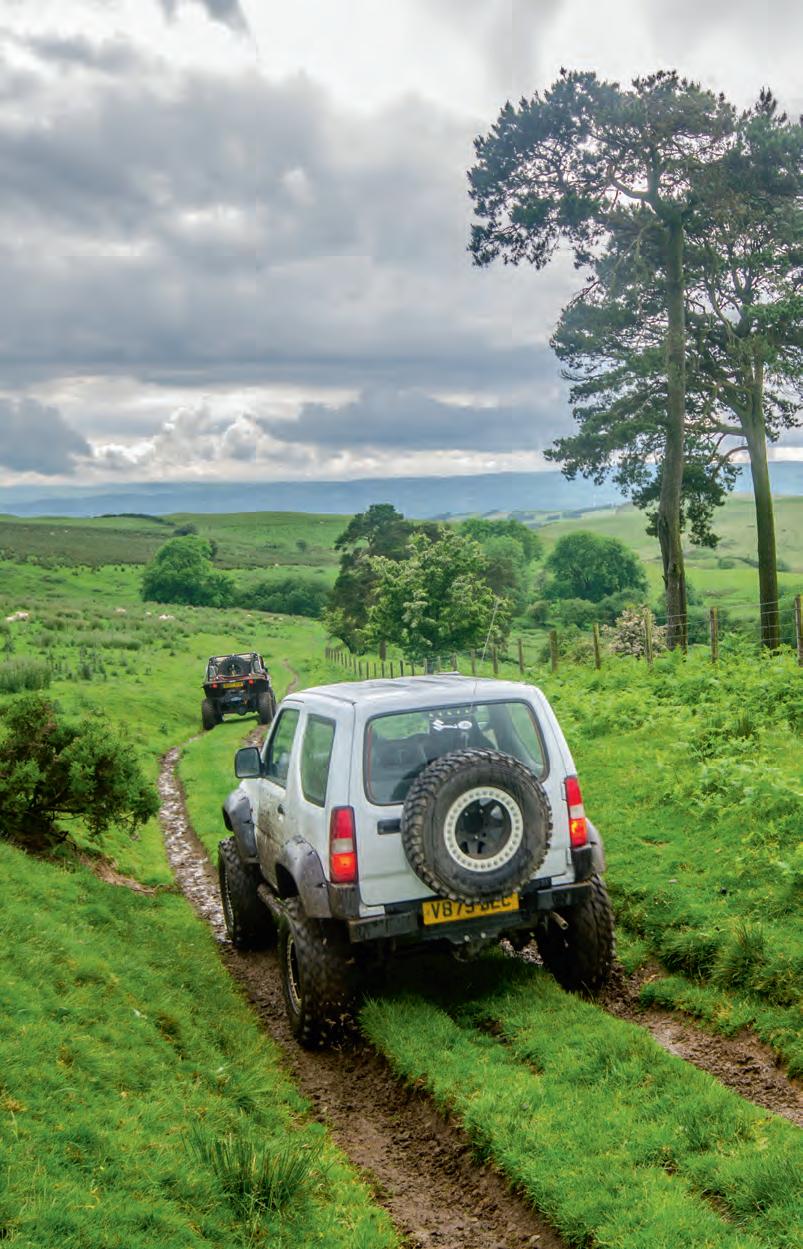




















Pay quarterly by direct debit and you can get Britain’s only all-marques 4x4 magazine delivered to your door – for less than half the price on the front cover!
4 News
An all-new double-cab arrives in Britain from China’s GWM, while Land Rover finds more ways to move its vehicles further upmarket than ever
10 Rights of Way
A snapshot of a GLASS rep’s ongoing activities illustrates just how much we’ve got to be grateful for that they’re working to protect our lanes
14 Products
ARB’s ultimate roof tent becomes available through Isuzu’s main dealer network, and what was once the look for Land Rover’s ultimate status symbol remains available through Rimmer Bros
54 Subscribe
Get Overlander 4x4 delivered for a fraction of the cover price
64 Next Month
A restified Discovery 2 leads the way in a Land Rover special issue
18 Kia EV9
The brilliant premium SUV becomes more brilliant than ever in six-seater form
22 Jeep Avenger
We weren’t that taken with it in petrol-engined form but electric power is the making of it
42 Coolest 110
Defenders already look cool with no roof. Add a world-class restified treatment and it’s off the scale
48 Everyday classic Jeep
You don’t see many CJ7s still being used off-road, or as dailies. This one is both
24 Green lane routes for autumn

Covering the length and breadth of England and Wales, a set of guides for adventures on our land’s wonderful rights of way
56 Zimbabwe
The second instalment in the story of an overland expedition in the heart of Africa
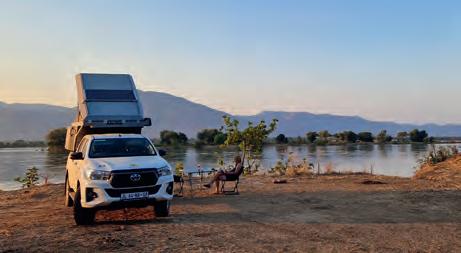


When Fiat, Mercedes, Nissan and Mitsubishi all exited the double-cab market in a short period of time, it felt rather like the pick-up bubble had burst. After a spell in the doldrums, however, it got its first new name in several years when the Ineos Quartermaster came along – and now we’re about to get another addition to the range of one-tonne choices in the shape of the GWM POER300.
This is at the other end of the price spectrum from the Quartermaster, which is just as well with a name like that. It’s pronounced ‘power’ (first rule of names for cars is that if you’ve got to explain it, you shouldn’t have called it that) and it costs from £31,495 plus VAT.
Talking of explaining it, the GWM stands for Great Wall Motors. Yes, the Chinese giant behind the Steed is having another go: safe to say this one should be a lot better.
The POER300 is a traditional pick-up in that it’s diesel engined. The engine in question is a 2.4 turbo which puts out 183bhp and 354lbf.ft. That latter figure in particular should make you sit up and take notice. It’s paired as standard to a ninespeed automatic transmission and fulltime, dual-range transfer case, and as well as returning 32.7mpg on the combined cycle it can carry a payload of 1000kg and tow a braked 3500kg.
All the right numbers there, then. It qualifies as a commercial vehicle and it does all the things you want from a 4x4 pick-up. It has 230mm of ground clearance and approach and departure angles of 27° and 25° respectively – as well as a locking rear diff as standard. Oh, and ‘multiple intelligent all-terrain modes (Normal, Eco, Sport, Snow, Mud, Sand)’, which is super but they had us at locking rear diff.
It also has a 12.3” touch-screen media system with wireless Apple CarPlay and
Android Auto, a 7.0-inch digital dashboard and a wireless charging pad within a cabin trimmed in premium soft-touch materials. Roof rails are standard too, as are integrated side steps.
Over and above this, at the time of writing the final UK specifications were still being finalised. However GWM expects there to be a three-strong range with trim levels called Lux, Ultra and Vanta. If this sounds to you like the names of a drag-queen Bananarama tribute act, we’re on the same wavelength.
Lux gives you 18” alloys, LED headlights, leatherette seats, voice control, rear parking sensors, park assist and ‘extensive safety assist features.’ Move on up to Ultra and you also get heated and ventilated seats with power adjustment, real leather trim, ambient lighting, privacy glass, a sunroof, front parking sensors, a tailgate step and a 360° camera. Sounds like the sweet spot in the range, that, but






if only blacked-out exterior trim, black wheelarches and black alloy wheels will do, it’s the Vanta for you.
The £31,495 mentioned above gets you the Lux, with the Ultra costing £34,830 and the Vanta taking it to £36,830. Whichever you go for, you’ll bring it home with a 5-year/125,000-mile warranty.
‘With the POER300, GWM UK is delivering unmatched utility, power, and technology at a very competitive price point in the UK market,’ says MD Toby Marshall. ‘We fully expect the GWM POER 300’s combination of capability and value to resonate strongly with small business users and rural dwellers, who rely on vehicles such as this as a backbone of their businesses and lifestyles.’
We’ll be driving a POER3000 between now and our next press day. So look out for our first on and off-road driving impressions of the vehicle in the next issue of Overlander 4x4



You might have thought the Octa was already the ultimate version of the Defender. But now here’s the Octa Black, ‘combining extreme all-terrain performance with an even bolder appearance.’
Powered by the familiar 635bhp twin-turbo V8 engine, like every Octa this comes with 6D Dynamics suspension and a special Octa setting in its drive mode palette. What sets it apart is the use of either gloss or satin black on as many as 30 different exterior elements,
to go with the Narvik Black paint that comes as standard.
Said elements include the front undershield and rear scuff plates, which are finished in satin black powder coat, the satin black recovery eyes and the gloss black quad exhaust tips. Even the traditionally green Land Rover oval on the grille is black with darkened silver script, while the silencer and centre box covers and optional towbar (electrically deployable, natch) have a gloss or satin black finish.
The brake calipers? Black, with silver script. The wheels in front of them? A choice of 20” forged alloys or 22” gloss black jobs, with black centre caps and dark grey Defender script.
The interior features black semi-aniline leather with Kvadrat, used for the first time in a Defender, to add a soft and tactile finish to the seats. The dash panel features exposed areas in satin black powder coat, while an optional chopped carbon fibre finish can be chosen for the interior details.

‘There’s no denying the presence and purpose of Defender Octa,’ commented Defender boss Mark Cameron. ’It’s the tallest and widest Defender, enabling it to tackle even more extreme terrain.
‘The introduction of Defender Octa Black takes things up a notch. We know our clients love giving their Defenders all-black finishes, so our designers have applied this principle to every possible surface – inside and out – to create the ultimate tough luxury Defender Octa.’ It’s priced from £158,045.

THE LATEST ADDITION TO THE RANGE ROVER SV FAMILY IS THE SV BLACK –an ‘exquisite interpretation of luxury and personalisation’ which Land Rover calls ‘refined elegance in its purest form.’
Mainly, it’s black. Whether or not in its purest form is for you to decide, but there’s a LOT of black stuff here. Land Rover describes it as ‘dipped in black’ –the body is finished in Narvik gloss and there are matching details and finishes everywhere you look, some of them never previously available on the vehicle.
Inside, it’s… black. Black leather, black veneers, black ceramic gear shifter, you name it. A new generation of more sustainable and longer-lasting tyres will be introduced across the Range Rover model line later this year, and they’re black too.
It’s about more than just blending in at Sisters of Mercy concerts, though. The SV Black is equipped with Sensory Floor,
an evolution of the Range Rover’s BodyAnd-Soul-Seat technology, which uses haptic feedback through the floor mats to enhance the experience of listening to music. ‘Sensory Floor creates precisely synchronised pulsations in the floor, harmonising with the Meridian Signature Surround System and haptic seat technology using AI optimising software,’ it sez ‘ere.
The new technology is fitted in the front passenger and rear footwells of all longwheelbase Range Rover SV models as standard. The driver doesn’t get it, which seems odd because the system also offers a range of wellness programmes whose ‘measurable benefits’ include reduced stress and improved concentration.
Orders for the SV Black will open in late 2025. It will be available in five-seat, standard-wheelbase and four or five-seat, long-wheelbase form, in each case powered by the familiar 615bhp V8 engine.




The SV Bespoke commissioning service, which allows Land Rover’s wealthiest clients to have their vehicles built to a specification unfettered by the boundaries of cost or taste, has been extended to include the Range Rover Sport. Previously available only on the Range Rover itself, the service creates one-of-one editions by offering a massively extended range of design options.
These include up to 230 gloss, matte and satin paint finishes, 1500 interior combination with 15 different main colours and various ‘exquisite design details’ including unique wheels, veneers, kick plates and seat embroidery as well as hand-forged two-piece precious metal script badging.
If all that isn’t enough, there’s also a match-to-sample paint service for clients who ‘wish to truly express themselves.’ Or just want a car that’s exactly the same colour as their favourite pants.
In addition, every Range Rover Sport ordered (Land Rover says ‘crafted’, which may be less pretentious than ‘curated’ but is still apt to make you sneer) with
Bespoke gloss paint also gets a new ‘glass-like’ gloss finish. This is created using and a custom flatting and polishing process along with a thicker top-coat lacquer – sounds like they’ve borrowed a technique from the world of hot rods there, and those are probably the best presented cars in existence so that’s no bad thing.
Those 15 colourways for the interior include Navy, Brogue, Pimento, Ecru, Lunar and Raven Blue. In at least some cases there, we can’t begin to imagine the colours those names represent, but given the more or less endless range of options for contrast stitching, personalised embroidery and custom veneers, the chances of any two ever looking alike are reassuringly slim.
The first example of an SV Bespoke Range Rover Sport is called Nocturne. Named after the noise you get when a steering swivel’s on the way out, this is finished in Bespoke Indigo Gloss with black mirror caps, a contrast roof and an exposed carbon bonnet. There’s further carbon on the exterior, along with black chrome badging and 23” Thunderball wheels in Champagne Gold Satin.



If you’re looking at the picture and thinking it doesn’t look as tacky as all that makes it sound, and you’ve got the sort of money it takes to go about in ‘the ultimate personalised luxury performance SUV,’ the good news is that there’s an SV Bespoke Global Commissioning Suite near you. Well, there is if you’re in London, Antwerp, Munich, Vancouver, Beijing, Tokyo or Dubai, but there are five more coming before the end of the year (‘including additional suites for clients in the Middle East,’ says Land Rover, which sounds quite telling). Virtual commissioning is also available, but for this kind of money you want to be fawned over in person.
‘Since we introduced SV Bespoke for Range Rover, we have seen a surge in demand for our personalisation service,’ says Range Rover boss Martin Limpert. ‘Our clients are increasingly looking for crafted details and true distinction.
‘Our ability to offer discerning clients exactly what they are looking for brings a new level of personalisation and unparalleled attention to detail. We go on the journey with them to curate and create their dream vehicles.’

The original Minilite wheel, was probably the most successful competition wheel of the 1960’s and 70’s. As the name suggests, it was originally developed as a magnesium competition wheel for the then revolutionary new Austin ‘Mini’, but its instant success meant that it was soon to be seen on many of the serious race and rally cars of that era. A new iconic style was born, and to this day, all genuine Minilite wheels are made to that original classic design. Originally conceived for race and rally, demand soon grew for road car applications, and has remained so ever since. Minilite wheels are ‘Low-Pressure’ die cast, in high grade aluminium alloy; machined on the latest CNC equipment, 100% pressure tested, and finally powder coated for maximum protection against the elements.


> Load Rating: 1,220kg
> Offset: ET0
> PCD: 5 x 165.1
> Weight: 11.7kg
> Test Standard: JWL



EVERYONE HAS THEIR OWN FAVOURITE PART OF THE COUNTRY FOR GREEN LANING, but nowhere can match Wiltshire for the sheer number of rights of way it offers. Salisbury Plain is the focus, of course – but the rest of the county, too, is criss-crossed with a huge number of byways and unsurfaced roads.
This opens up huge possibilities for 4x4 drivers, of course – but it also means there’s always something for John Lippiatt, Wiltshire rep at the Green Lane
Association, to be doing. Actually, normally there are several things at once. John recently shared an update on his work in the Association’s monthly Bulletin, inviting readers to pass it on to anyone who shows an interest in visiting the Plain. Education is a huge part of GLASS’ mission to improve the lanes – so we’re happy to assist by doing just that!
The section of the Herepath (right) which runs up the northern flank of Avebury Down to its junction with the Ridgeway (main picture) is gently scenic and entirely sustainable – so long as it’s used sensibly. It’s a cause celebre both for green lane users and those who want to see the hobby banned – seasonal closures from the start of October to the end of April help protect it from the wrong kind of use, but even when it’s legally open it’s still best practice to keep clear in wet weather
John says that no Voluntary Restraint requests are currently active in the county. This is as it should be at this time of year, however some signage has been left in place ready for the coming winter – the thinking being that seeing the signs will


alert users that the lane may be susceptible to damage in bad weather conditions.
In addition to this, the permissive byway which runs parallel to the northern transit route on the Salisbury Plain Training Area has been re-levelled and the low spots have had drainage added. This was done by the MOD as a training exercise for the Royal Engineers. We have some experience of how deep these low spots can be, having got stuck in water over the tops of our wheels early last year during a photoshoot with Isuzu – and while the route certainly was more of an off-tarmac challenge than the graded Cat A track alongside it (which itself is a Byway Open to All Traffic), its condition had prompting concerns over safety. On one occasion, a vehicle rolled on another part of the track.
‘I think we are very lucky that they did not just close our access,’ comments John.

‘Being a permissive route, this would have been an easy choice.’ A reminder that the MOD is a landlord which understands that 4x4s are not the devil and welcomes drivers not just on rights of way but many of its own private tracks too – in return for the courtesy of behaving responsibly and not going where you’re not allowed.
On that subject, John says that he has recently become aware of an increase in the number of people who visit the Plain without having done any prior research into what they might expect. ‘I have often come across visitors with no maps or plan of any sort of route,’ he explains. ‘There is a misconception of how far one might have to go to get help if a problem occurs.
‘Also, there seems to be a lack of awareness as to where one certainly should not go.’
To help people avoid falling into these traps, John has a series of resources he gives out when he meets visitors on the lanes. Long web addresses aren’t the easiest thing to work with on paper, but we’ve included his list on a separate panel overleaf and we’d earnestly encourage you to arm yourself with all the information the links contain before visiting the Plain, whether you’re a first-timer or an old hand.
Away from the military areas, the section of The Ridgeway close to Avebury village remains a cause celebre. We drove it one summer evening a few years ago, not realising that we’d only gone and chosen the night of the solstice to go laning, and it was absolutely rammed. We’ve rarely been in such a cheerful, chilled and good-natured gathering, though the kind of people who see anyone doing anything and shriek They Must Be Stopped while beating their little fists on the arms of their Victorian rocking chairs would no doubt see it differently.
These are of course the same people who refuse to believe that green laners can be anything other than loutish hooligans hell-bent on destroying the countryside. And while that view is every bit as wrongheaded as the kind of behaviour it seeks to ascribe, there’s no point in pretending that irresponsible 4x4 drivers do exist. And, of course, their behaviour is a gift from the gods for the anti-freedom brigade.
That’s why it’s crucial to be an ambassador for the hobby when you’re out on the lanes – and sensitive routes like those around Avebury are where the greatest attention is focused. ‘This route attracts a lot of attention from those who wish us excluded,’ confirms John. ‘So it is essential that we be seen as the good guys. Please can I ask all GLASS members to exercise good judgement on the day if you intend to drive it. Personally, I will only be driving it if the surface is dry.’ Voluntary restraint is a specific thing, but it’s also a good watchword for your everyday laning activities every day of the year.
Another cause celebre in the area is the group of byways clustered around the immediate vicinity of Stonehenge. These are entirely sustainable and well used by a good many vehicles (not just 4x4s), however their location is seen as
Top: The permissive byway which runs parallel to Salisbury Plain’s Northern Transit Route has long been known for its ability to snare vehicles. As we, ahem, know only too well. It has recently been resurfaced as a training exercise for the Royal Engineers, who also added drainage to help prevent repeats of the above – a big win for the laning community, as it would have been very easy for the MOD simply to withdraw permission
Left: Over many years, the Green Lane Association has been working to erect finger posts across the Plain – a huge exercise, and one that’s a bit like painting the Forth Bridge, but it has been an absolute game-changer for rights of way users in the area. It has since extended the programme to the rest of Wiltshire – a county with a greater overall density of byways than any other
GLASS Wiltshire rep John Lippiatt recommends the following sources of information which, used in combination with the association’s own Trailwise2 site, will help you plan future laning trips to Salisbury Plain.
• wiltscouncil.maps.arcgis.com/apps/webappviewer/index.html
Online mapping for Wiltshire. By zooming in on the map, the reference numbers of the rights of way will appear. This allows cross referencing to the closures list. John notes that Wiltshire council no longer shows Temporary TROs on its online mapping system; these are now shown on Causeway at uk.one.network.
• apps.wiltshire.gov.uk/RightsOfWay/Closure/Search
Searchable guide to current rights of way closures (including voluntary).
• www.gov.uk/government/publications/ salisbury-plain-training-area-spta-newsletter Regular Salisbury Plain Training Area (SPTA) newsletter, including an overview of scheduled activity
• www.gov.uk/ government/publications/salisbury-plain-training-area-spta-firing-times
A list of timings for scheduled live firing, and associated closures to rights of way, on the Salisbury Plain Training Area.

• assets.publishing.service.gov.uk/government/uploads/ system/uploads/attachment_data/file/245198/ SPTA_Greenlaning_ Practice_Guide.pdf.
The official Greenlaning Good Practice Guide for Salisbury Plain. This has recently been reviewed and is often handed out by the MOD to help inform users. It was jointly produced by GLASS and the DIO with input from the TRF, the Police and Wiltshire Council.
an inconvenience to local tourism and at the time of writing they remain closed by a Temporary Traffic Regulation Order. ‘I have, as have many other members and the GLASS Rights of Way team, made suggestions and comments to the council of ways to improve the situation without resorting to closure to motorised users,’ reports John. ‘It is my belief that we are making some progress towards keeping this open to all and I will continue to push in that direction.’
The duties of a GLASS rep are indeed almost limitless – but so too are the multitudinous ways in which the job’s many roles can have a positive bearing on the way the lanes are managed at local authority level. Most observers assume that it’s all about fighting battles, but GLASS’ belief is that building bridges is far and away the most effective way of achieving good outcomes. Many reps are members of relevant local authority committees and working groups.

‘I am continuing to represent GLASS on the Definitive Map Modification Order working party,’ says John. ’This was set up to look at ways of reducing the current 40-plus-year backlog of applications. As the council is now under different political control following this year’s elections, one can only hope that policies might change… but I won’t be holding my breath.’
One group of people that certainly has been making progress is GLASS’ own Rights of Way signing team. This was originally set up to erect waymarkers on the Plain – where the number of rights of way, the uniformity of the landscape and the amount of tracks made here, there and everywhere by Army vehicles meant navigation used to be notoriously difficult –but has in more recent times expanded its reach and now maintains signage all over the county.
If you’ve been laning in Wiltshire, especially on the Plain, you’ll know that this has been an absolute game-changer. ‘I think I can speak for everyone by saying a big thank you to all who have helped with this over the years,’ comments John – and we couldn’t agree more.


BORDAQualifiedInstructors
BORDAQualifiedInstructors
1:1OwnerDriverTraining
1:1OwnerDriverTraining JuniorOff-RoadExperiences
GiftVouchers
Bespoke1:1or2:1Courses Groups/Corporate/Stag&HenEvents
Professional4x4OffRoadTraining (PUWER)
E:info@whitecliff4x4.co.uk







Here at FreelanderSpecialist.com, not only will we fix the problem but we will look to determine why the problem occurred and discuss with you how you can avoid it happening again in the future. Our di erential units are uprated, making them stronger than the originals.




Isuzu has announced that ARB’s topof-the-range Altitude rooftop tent is now available through its UK dealers. The premium tent option was added to the company’s ARB accessory range to celebrate the first anniversary of its ARB Hubs – a network of specialist dealers with access to exclusive stock, training, promotions and showroom tools to better serve customers buying a D-Max with camping and off-roading in mind.
The Altitude is very much for the kind of people who don’t want camping to mean the same thing as roughing it. In Isuzu’s words, it ‘redefines camping convenience, combining automated open and close functionality at the touch of a button with panoramic 360-degree views, premium materials and clever storage solutions. The Altitude,’ it continues, ‘is the ultimate choice for those who want to explore off-grid in style and comfort.’


ARB says of the Altitude that ‘the idea was to have a tent that would set itself up and pack itself down at the touch of a button.’ It’s powered by a pair of actuators on each side, with a steel scissor mechanism for Raising and lowering and internal controls for durability and protection against the elements. It contains a 1370 x 1870mm double bed made from 70mm thick dual-density foam and a 17mm honeycomb base core for strength and insulation. When erected, an internal height of 1180mm gives you plenty of room for lounging and changing.
Prices for the Altitude, and indeed for all ARB accessories, are apt to differ from one Hub to the next, however on the importer’s own UK website it’s only a squeak under £5400. For that money, you get every feature the Aussie 4x4 legend can think of. And they’ve been thinking for a long time now, so that’s a lot.

This being Britain, it’s relevant to mention that those features include drainage points in each corner of the base, ensuring that the shell won’t start to fill up even in heavy rain. These are then blanked off by grommets when the tend is closed, preventing dust from getting in when you’re on the move. Told you they’d thought of a lot. A wind deflector to prevent buffeting and drag? Of course they have.
This sort of stuff is the reason why Isuzu partnered with ARB in the first place. Its ARB Hub programme has established a dedicated network of main dealers specialising in the Australian company’s 4x4 and camping accessories, where you can expect expert advice, hands-on experience with ARB products and the ability to equip your D-Max with everything from roof tents and camping accessories to recovery gear and storage systems. There’s more information to be found on Isuzu’s own website.

£79.95 | www.mobilesolarchargers.co.uk

SOLAR CHARGERS have been specialising in fit-forpurpose portable power banks, jump starters and solar charging solutions for well over a decade now. Whether your requirement is power for occasional short trips, emergency backup or a portable off-grid solution for long-term expedition travel, the company promises to have the appropriate mix of solar panels and batteries to suit your own personal needs. Based in Somerset, the company stocks a wide range of chargers with folding solar panels, which between them create power to store in a power bank. These are suitable for indefinite off-grid travel – and to prove the fact, their efficiency and capacity has been tested by travellers to extreme environments like the Himalayas, Kilimanjaro and the Arctic.
Buying direct has long become the recognised way of not being saddled with knock-offs or third rate lookalikes, and in the case of Mobile Solar Chargers it’s more than just a good shopping habit – it’s essential. The company stresses that its products are not available on Amazon or eBay – go to the source and you know what you’re getting.
Its products have some serious accolades to boast of, too. ‘Our Overland jump starters are winners of four Auto Express Best Buy reviews,’ it says, ‘and we were named Portable Charging Solution of the Year by the Luxury Travel Guide.’

As well as being excellent, expedition-proven power banks, these Overland jump starters are also powerful enough to fire up anything from a generator or lawnmower engine to a hulking great 5.0-litre diesel. They are recharged via mains or car inputs or, of course, one of the company’s our solar chargers. Overland Jumpers are available from the £79.95 mentioned above. The company also has a range of solar special offers, however, prices for which start at £87.75.




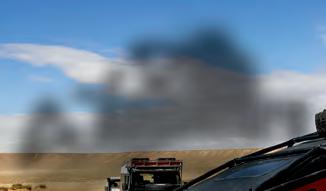


















IF YOU’RE HEADING FOR THE LRO SHOW AT BELVOIR CASTLE, near Grantham on 6-7 September, among the companies you’ll find exhibiting will be Lincolnshire based Land Rover and Range Rover parts specialist Rimmer Bros. In conjunction with this, the company is offering a 10% discount, along with free delivery to the show for you to collect from its stand, until midnight on 7 September.















You can place orders via phone to 01522 568000, by email to sales@rimmerbros.com and on the website at www.rimmerbros.com. Quote the show offer to get your discount and free delivery to the show.
£1080-£1092 inc VAT | www.rimmerbros.com
IF YOU WANT TO MAKE A RANGE ROVER CLASSIC STAND OUT FROM THE CROWD, a sure-fire way to do it is to fit a Brooklands bodykit. These are still available today – indeed you can get separate versions for two-door, four-door and long-wheelbase LSE models from throughout the vehicle’s 25-year production run.
The kits include a front bumper, a rear apron and a pair of sills, all of them moulded in GRP. You also get a set of chrome insert strips as well as all the screws, nuts, washers and rivets you’ll need for fitting. Oh yes, and a full set of instructions, which you’ll also need for fitting.
Prices at Rimmer Bros are the same for two and four-door models and just a trifle more for the LSE. Though if you were to turn a straight example of the latter into a Brooklands now they’re into their fourth decade on the planet, the cost would be more than just financial. The same could be said of an early two-door, obviously. Still, there are plenty of Range Rovers out there that could wear one of these kits well.
Retro-fit air-con for Puma-era Defenders
ca £2500 plus VAT | www.britpart.com
IT MIGHT BE A CASE OF FINALLY GIVING IN TO THE INEVITABLE, but more and more people who do Defenders are

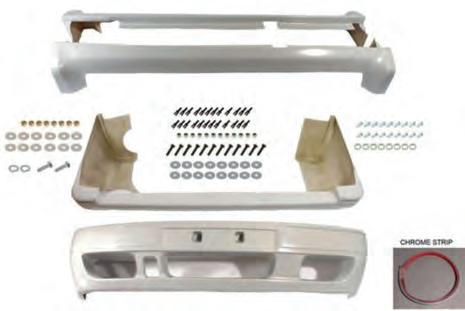
doing Pumas now. There’ll always be mutterings about… well, everything… but say what you like, they’re still original Defenders and they are more modern than earlier ones in their own still-not-really-very-modernat-all kind of way.
One big way is of course that they have proper heating and ventilation systems. And since more customers were going for high-spec ones towards the end, a greater proportion than before have air-conditioning. But there are still plenty of utility models out there,
waiting to have the usual done to them when the time comes for a galv chassis and a kick upmarket – and retro-fitting an air-con system as part of the job is not as fearsome as it sounds.
That’s because Britpart’s DA2344 AirConditioning Kit comes with pre-assembled components to make for an easy installation. It plugs straight into the existing Land Rover wiring loom and fuse board and as as-OE, meaning once fitted it’s indistinguishable from factory units.
The kit uses a high-performance condenser, meaning you don’t need an extended nose cone to fit it in, and all the parts within it are interchangeable with Land Rover’s own.
























Kia was Britain’s fourth biggest car brand when it launched the EV9 a year and a half ago. Now it’s the third biggest, having registered 62,005 new vehicles in the first half of 2025 – with just over half of them being either HEVs, PHEVs or full EVs.
Volumes like that come from everyday vehicles like the Sportage (Britain’s second highest selling car of any kind), Picanto (up 35% on the same time last year) and EV3 (more UK retail sales than any other EV). But Kia’s halo model is doing very nicely too.
As we’ve said before, the EV9 is a statement vehicle for Kia. It’s a properly premium SUV with exceptional equipment and build quality – and in the GT-Line S AWD 6-seat form tested here, it retails at £77,035.
That’s at the bottom end of BMW X5 and Merc GLE money and mid-range for a Land Rover Discovery or Lexus RX, which instantly makes it look like pretty strong value – particularly as it’s getting you an EV (which, like them or not, still cost more up front than the petrol or diesel equivalent). It’s still quite a sum for a Kia, however,
especially to those of us old enough to remember the brand’s first decade or so of selling el cheapo snoozemobiles like the Clarus and Magentis.
In reality, very few people will actually buy an EV9. If you’ve got a business, however, or can otherwise can into one as a company car, electric vehicles are more or less mandatory now – and the tax incentives mean they make overwhelming financial sense. So the whole ‘that’s a lot of money for a Kia’ thing is dinosaur talk in more ways than one.








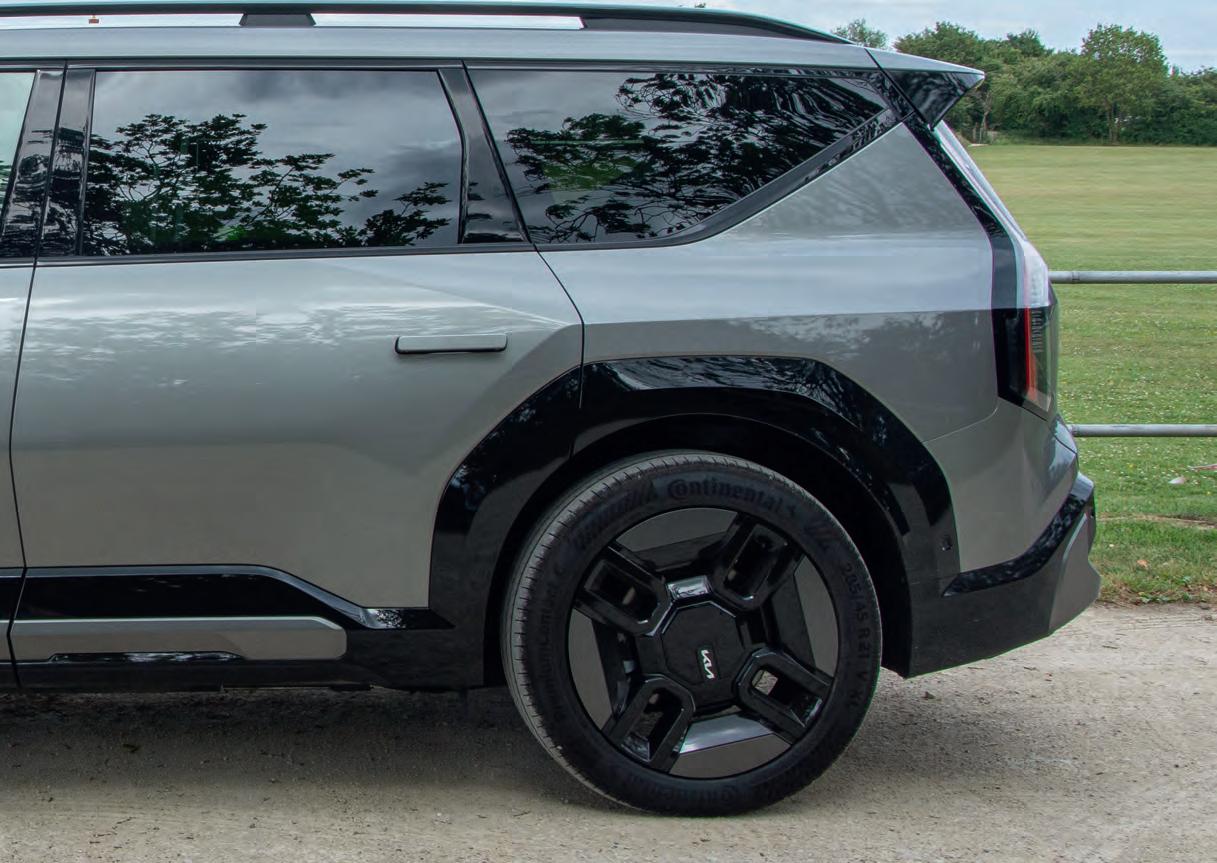
Enough of the justifying it, anyway. Let’s talk about the actual car.
The EV9 tested here differs from the last one we drove in that it’s a 6-seater, so let’s start there. It’s a 2+2+2 layout, with individual captain’s chairs instead of a traditional second-row bench. These slide back and forth, through a range that allows the vehicle to accommodate six adults in bountiful comfort should you need it to, and also rotate to face backwards. It’s not as
spacious in this configuration as something like a VW Caravelle, but it creates a ‘room’ for your family to travel in.
There’s also a small table that slides out from the back of the floor console to sit between the second-row seats. This doesn’t add bucketloads of practicality but it’s useful and usable and if nothing else it adds an extra little dollop of surprise and delight.
There are bucketloads of practicality elsewhere, at any rate. The seats give you stacks of leg, head and elbow room and if you’re the driver they give you a massage,
too. It’s like being in an SUV but also distinct from the everyday driving experience –there’s an air of detachment which, while it might not please the everything-must-bea-Ferrari breed of motoring journalist, dials right in to the essence of what a modern family vehicle is all about.
They’ve nailed the load-carrying side of the practicality coin, too. And how. The third-row seats fold flush into the floor at the touch of a button on the side of the boot wall, which is very convenient (they come back up the same way too), and even when

You might need a double-take, but that’s the second row of seats in the picture above. Those to the right show the front of the cabin, which is beautifully crafted and extremely usable. It makes practicality feel luxurious
they’re in place you can still get a significant bit of cargo in the space behind them. When they’re down, the space is like what you expect of a typical SUV with the second-row dropped flat – and yet you’ve still got five seats to play with too.
Drop the second row as well, which again can be done from beneath the tailgate using buttons on the boot floor, and you’re presented with an enormity of luggage space. When we first drove the EV9, we described it as being ‘about the size of a bedroom in the typical new-build estate home’… well, the editor has looked round quite a lot of typical new-build estate homes since then and he’s now of the view that it’s more like the garden, not just a bedroom.
If the second row is off flat, it’s only by a degree or two, and the sheer volume of space available takes your breath away. The fact that there are two second-row seats rather than a bench means there’s a big hole in the floor, which can have a bearing on how you’re able to load it, though this also introduces new opportunities for accommodating tall or oddly shaped items. Either way, it’s as immense on the inside as it appears from the outside, and whether for people or luggage it makes tip-top use of every last bit of the space made available by its dedicated electric platform.
Driving it, the six-seater is indistinguishable from the rest of the EV9 range. In AWD
form, it has twin motors generating 378bhp and 516lbf.ft, which is more than enough to give it a lurid turn of pace. The quoted 0-62 time of 5.3 seconds sounds extremely conservative to us; certainly, 0-30 feels more or less instantaneous and you don’t so much overtake people as monster them.
More importantly, it’s very easy to drive smoothly. It’ll take off without a jolt and gather speed with no drama at all; if you’ve got passengers with their faces in their phones, you could leave the lights and be cruising at half a ton with only a swoosh of


tyre noise to tell them you’re moving at all. This is quite an achievement when you’re riding on 285/45R21s and there’s no engine note to blur the road noise.
Considering this is a big, tall vehicle with an imposing kerb weight of 2674kg, ride quality is also remarkably civilised. Even the kind of desperate pot-holed shambles that passes for a road network in depressingly large parts of urban Britain don’t confound it. You do feel it working to keep things smooth at times, but it succeeds. The bumps are muted and the impacts are



Another double-take… what you’re looking at above left is the luggage space with all three rows of seats up. The third row is raised and lowered electrically using buttons on the boot wall; as well as a 16-amp three-pin socket, the panel also includes buttons for dropping the second row – whereupon the cargo space on board truly does become van-like
distant and well damped; the EV9’s body stays stable when the road is trying to upset it, and its suspension refuses to succumb to relentless jolts and vibrations.
Considering the spectacular pace on offer, the EV9 comes across as effortlessly fluid rather than boorishly fast. There’s a GT model out now with 502bhp, 546lbf. ft and a 4.6-second 0-62 time, and this has suspension, braking and drive mode upgrades to go with its extra power, so if you want to make a driver’s car out of it
you certainly should be able to, but as it is the AWD model’s twin motors make it very pleasing indeed. You can drive it quickly but calmly; people who scuttle off to the bathroom every afternoon with a copy of Octane will probably hate it, but for a very modern, superbly equipped electric SUV that’s as quick as you’ll ever want it to be, it really is a remarkable achievement.
As is Kia’s rise through the ranks of car makers to take third place in the market.
The EV9 shows that what was once a

budget brand has transformed itself into one capable of building credibly premium vehicles that set the agenda in their corners of the market. This is a sensational SUV – and in six-seater form, it gains an extra touch of MPV-like practicality that takes it to another level as a do-it-all family wagon.


We tested the petrol engined Jeep Avenger a few months ago – and to our surprise we didn’t like it very much. There wasn’t a great deal about it to dislike (though we were horrified to find that the bodywork in the engine compartment hadn’t been fully painted) but very little to get excited about. Our conclusion was that the EV version is better.
Here, we’re taking a quick look back at why. The Avenger was initially launched here as a 4x2 EV, with the aforementioned petrol model coming along later – in addition to an e-Hybrid and the all-wheel drive plug-in 4xe. List prices start at £26,050 (petrol), £27,050 (e-Hybrid), £29,999 (EV) and £31,219 (4xe).
So the EV is not bustingly expensive as EVs go, even when you climb the range (there are three models, with the top Summit model giving you the full works for £33,999). It has 156bhp and 192lbf.ft, it’ll go from 20%-80% in less than 30 minutes with a fast charger and it’ll cover up to 248 miles on a brimmed battery. And. overall, the Avenger has been responsible for something like a tripling of Jeep’s sales in the UK, so whether you prefer to plug in or fill up it’s clearly doing great things as a vehicle.
Now, we know that the bulk of the people who choose vehicles do so based on things like its looks, cabin, media system, brand name and whether you can get it in a nice colour. Jeep certainly ticks the brand name box and the Avenger collects all the others, too.
The groovy cabin atmosphere hits you the moment you get in and admire the sculpted features of the dash. And they’ve pulled of a real trick here, because despite being made from what feel like budget materials it manages to look cool, classy and high-quality. The design is eye-catching, the overall impression of something modern, premium and very cool.
This in spite of there being a lot of hard, scratchy plastic on the dash surfaces and a couple of stowage areas that feel almost flimsy. Instead of letting you linger on these things, however, the design pulls you via a body-coloured horizontal trim piece to an excellent nav screen and high-res digital dashboard. It looks really nifty and we can well imagine many a potential customer being convinced by it.
The seats are good and comfortable, whether trimmed in fabric or leather, and there’s plenty of space up front – though
the rear is definitely best left to children. The boot behind them is adequate for a family vehicle of the Avenger’s size, though if you want more room for luggage it’s compromised by the seats only folding a long way from flat.
This is all Avenger stuff rather than Avenger EV stuff, so let’s get on to that. Those 156bhp and 192lbf.ft don’t sound like much but boy do you feel it. The initial surge is good, but then it’s followed up by a wall of torque all the way through the mid range. There’s not a lot left when you reach cruising speed but by now the thrill of the chase has been replaced by the smell of success, with little in the way of wind noise or fussing from the road to upset you.
It deals well enough with the post-apocalyptic stuff around town, too, and it handles with predictable steering and reassuring grip and control. Its body is moved around a little by really uneven roads but its ride is never harsh and it stays stable even under fully committed cornering.
And all this without four-wheel drive. Which means this isn’t a real Jeep, right? Well it’s not a Wrangler, that’s for sure, but seldom has there been a more dramatic demonstration of how modern electronics can step in. Jeep gave us a traction demo track to drive over, which included an obstacle that lifted one of its driving wheels about a foot off the ground while going uphill. We can all think of at least one traditional 4x4 that would have struggled in that situation, especially as the surface beneath our wheels was wet – but the Avenger kept moving. No need for any revs, either, of course, with that electric motor giving its best from standstill.
Yes, there are areas in which the Avenger feels like it’s been built down to a budget, not up to a standard. The fact that they jar so much says something about how good it is overall. We’d still shuffle our way towards the 4xe, whose added off-tarmac intent adds another level of appeal – but if you’re after a small electric SUV that puts a smile on your face, Jeep does have you covered.


Engineered to improve mud traction ▐ Formulated to improve wet traction, KO3 stops 4.2 shorter than the KO2


▐ Designed to maximize handling and traction on- and off-road by stabilizing the tread center and providing biting edges for off-road traction
















The tracks in our routes are either Byways Open to All Traffic or Unclassified County Roads. All are legally open to vehicles.
Navigation
We’ve tried to keep our notes as clear as possible. When you’re out on the trails they should all make sense.
We try to include instructions only where you need them. This means junctions at which you have to make a turning or don’t have right of way. So just stay on the main road/track or take the most straight-ahead option unless we tell you otherwise.
Our notes include six-figure grid references. Our aim is for you to be able to do the route without maps, but we do recommend having them.
Our notes aim to warn you of any hazards, but the nature of any lane can change quickly. Wet weather, erosion and seasonal
growth can all make a huge difference to the conditions. The responsibility is yours!
The routes are designed to be safe to drive solo. We do recommend travelling in tandem wherever possible, however. The risk of getting stuck can be greater than it appears – and if you break down, having help at hand will make all the difference
Where our notes mention the routes’ suitability for soft-roaders, we’re referring to vehicles like the Freelander. Crossovers are excellent on smoother tracks but will ground out too easily to be of real use for green laning.
Irresponsible driving is a massive problem on green lanes. In particular, you must always stay on the right of way. Never drive off it to ‘play’ on the verges or surrounding land, even if you can see that someone else has; it’s illegal and tremendously damaging, both to the land and to 4x4 drivers’ reputation.






Elsewhere, common sense and courtesy should be your watchword. Keep your speed down, be ready to pull over for others and always aim to show the world that 4x4 drivers aren’t the hooligans they think we are.
Anti-4x4 bigotry is less common than you’d think. There are always bad apples but if you’re friendly towards people, the vast majority will be friendly back and many will be intrigued to see you.
Likewise, most local residents will accept your presence if you’re driving sensibly. What suspicion you do encounter is likely to be from people worried that you’re there to steal from them, so be ready with a word of reassurance
• Keep your speed right down
• Pull over to let walkers, bikers and horse riders pass
• Don’t travel in large convoys: split into smaller groups to avoid hassling others
• Leave gates as you found them
• Don’t drop litter
• Don’t go back to drive the fun bits, such as mud or fords, again
• Scrupulously obey all closure and voluntary restraint notices
• Don’t cause a noise nuisance, particularly after dark
• Ensure you have a right to be there. We research our routes carefully, but the status of any lane can change without notice
• Be prepared to turn back if the route is blocked, even illegally
• If you find an illegal obstruction, notify the local authority
• If someone challenges you, be polite. Stay calm and firmly assert your right to be there, but don’t let them draw you into a slanging match
• Stick absolutely scrupulously to the right of way
• You have as much of a right to be there as everyone else. Which of course means they have as much right as you
• Harrassing a legitimate right of way user is a criminal offence. Just so you know…





The evenings are getting shorter and the kids will soon be going back to school, but autumn is a great time for green laning. The ground is still nice and dry after the summer, but as the leaves on the trees start to turn golden the countryside takes on a whole new character. Here’s a selection of eight routes throughout the country that will take you out and about, get you close to nature and here and there present you with the occasional little obstacle to give your vehicle (not to mention your grey matter) a bit of a work-out!










ROUTE Llanfihangel Nant Melan to Rhayader 46.9 miles; 5-6 hours
OS MAPS Landranger 147 (Elan Valley & Builth Wells) Landranger 148 (Presteigne & Hay on Wye)
NOTES
Good, firm tracks, mainly well made and where ruts exist, they’re down to bedrock. No issues with scratching, but plenty with surface water in places. However one of these lanes has some significant rock steps which have become more pronounced over the last year or two; it was closed for a spell last winter and may be again during the next few months; even if it’s open, be ready for some very technical driving and stay scrupulously on the right of way. If you can’t make it over the steps, turn back – do not skirt round them on the adjoining land. There’s also a lot of road liaison on this route, and you should be alert for other users on the rights of way

• Before driving this route, or using any public rights of way in your 4x4, please read and pay attention to the notes on page 24



1
0.0 SO 170 584
Start at the Fforest Inn, on the A44 in Llanfihangel Nant Melan. Zero your trip and set off on the A44 for Rhayader
2
2.3 SO 147 605
Turn left to pass a no through road sign. When the tarmac ends, by a house on the left at 2.65, the road swings right and becomes a track
3
3.1
Follow the main track as it swings round to the left. At the T-junction with the road at 4.65 miles (it’s on the outside of a sharp corner), follow the tarmac more or less straight ahead
4
3.3 SO 110 596
Take the track directly ahead as the road swings hard left – it goes through the gate in front of you to cross a grassy field. It gets clearer up ahead. At 5.2 miles, it starts dropping down a steep descent, then the surface turns to tarmac at about 5.45
56.05
Turn left at the T-junction, then at 6.65 follow the road as it swings round to the right. It’s pretty narrow up ahead
68.55
Turn right, following the one-way signs, at the T-junction – it’s tight over your shoulder. Almost immediately, turn left at another T-junction, this time with a major road
78.9
Turn right for Newbridge on Wye. Turn left at the Tjunction at 10.8 miles, again for Newbridge on Wye
811.3
Turn right for Rhayader at the T-junction, then left on the B4358 for Beulah at 11.55
911.85
Turn right for Llysdinam; it’s signed as a no through road. At 13.2 miles, follow the main road as it swings square right at the crossroads-shaped junction
1013.45
Turn right at the first turning after Step 9. At 14.3, follow the road as it swings hard left across the bridge then, as the tarmac ends, take the track straight ahead
1114.6
Take the gate on the left. Follow round to the left at 16.15 as the track becomes a road and a driveway slips in from the right
1217.65
Turn left at the T-junction in the village, then again at another T-junction at 18.0 miles. They’re both signed for Elan Village
13
21.8
There’s a tight hairpin left as you drop down the hill towards the village. At 21.9 miles, look out for traffic coming in from over your right shoulder just after the cattle grid
1422.4
Follow the road as it swings right over the bridge. Turn left at the T-junction at 22.7 miles, then at 24.45 turn left to cross the reservoir for Dyffryn and Claerwen Valley
15
26.6 SN 901 616
Turn left opposite the parking area on the right. At 26.7 miles, ignore the track ahead and follow the road as it splits off to the right then immediately swings round in a tight hairpin in front of the big corrugated iron sheds
1627.15
When the road splits into two tracks, take the one on the right – it swings round to go to the left of a black corrugated iron shed. Shortly afterwards, go through the gate and continue straight ahead, then at 27.4 follow the main track as it swings round to the right
1727.9
Rock steps become a regular feature at about this point; some of them are quite severe. At about 28.6 miles you’ll come to the first of a series of water troughs
1828.5
Take it easy across the ford, then at 28.6 miles turn right over the bridge. Stay on this road to 33.2 and turn left at the T-junction for Aberystwyth via Mountain Road
1936.75
Follow the road as it swings right over the bridge. At 41.0 miles, turn right for Rhayader at the T-junction
2042.5 SN 921 709
Take the track that slips out to the left. There are no landmarks around it, but the track itself is very well defined and easy to spot
2145.1
Navigation gets tricky through a series of junctions. First, take the left fork at 45.1, following the red waymarker, then stay left when the track splits in two at 45.2. At about 45.35, you’ll come to a sort of cross roads with two tracks ahead of you – here, the red waymarker says to go left
2245.6
Follow the main track ahead past the house on your right, then shortly afterwards turn right at the T-junction with the road. Turn left at the next T-junction, at 45.8 miles
2346.4
Turn left for Rhayader at the T-junction and follow into town. The route ends at the fuel station at 46.9 miles



ROUTE Ridsdale to near Corbridge 20.5 miles; 2-3 hours
OS MAPS
Landranger 80 (Cheviot Hills and Kielder)
Landranger 87 (Hexham and Haltwhistle)
NOTES A mixture of grassy, gravelled and in places sloppy and wet tracks. A decent set of tyres is necessary, but by and large this is suitable for any 4x4 – though the final lane is scratchy for a short spell. You’re likely to see walkers and farm vehicles in places, and there are several stetches on very fast main roads

• Before driving this route, or using any public rights of way in your 4x4, please read and pay attention to the notes on page 24


1
0.0 NY 908 844
Start outside the Gun Inn, on the main A68 in Ridsdale. Zero your trip with the pub to your right and set off south on the A68, then turn left at 3.05 – it’s just after a cottage on the left and before a ‘blind summit’ sign on the road. Carry on ahead for Kirkwhelpington at 3.6 – it’s not obvious who has right of way here
2
4.4 NY 938 796
Turn right for Thockrington. The tarmac gets increasingly patchy, then at about 4.9 it turns to gravel as you start to run between walls and along a causeway over a reservoir. You’re back on to tarmac straight afterwards
3
5.15 NY 944 786
Where the road swings hard right, continue straight ahead for Little Swinburn. At about 5.5 miles, the road turns into a track. Turn left at the T-junction with another track at 5.95 miles; caution here, as you’re passing through a farmyard
4
6.95 NY 965 774
When you reach the crossroads, carry on ahead on to another track. Take care as you’re crossing the road – it’s a fast, busy one. After crossing another causeway over a reservoir, continue ahead at 6.9 miles then turn right at the T-junction with the road at 7.15
58.75
Carry on ahead at the crossroads, following the sign for Hexham, Corbridge and Bingfield. Turn left for Corbridge on the A68 at 10.95 miles, then right for Chollerford at the roundabout at 12.6 miles
6
14.0 NY 967 691
Turn left into a gap in the trees – it’s hard to spot as you approach. As you come down the hill towards it, watch out for a short patch of low tree growth – the turning is opposite that. The track gets quite rutted and prone to collecting water, but there’s a firm surface beneath it all
714.8
At the end of the track, turn right at the T-junction with the road. Turn right for Acomb at the staggered crossroads at 15.2 miles, then carryon ahead, again signposted for Acomb, at 15.9 miles
816.3 NY 954 676
Turn right on the track immediately before a large farm apron. The going gets quite tight and scratchy for a stretch at about 16.75. At 17.15 miles, pass the farm buildings on the right then, when you come to the T-junction on the outside of a corner, turn right to carry on more or less straight ahead, following the sign for Chollerford
917.7
Caution as you turn right at the T-junction with the main road. Turn right for Newcastle and Corbridge at the roundabout at 20.5 miles, then immediately arrive at the Errington Arms on the right for the end of the route
ROUTE Kirkby Malzeard to Kirkby Malzeard 24.9 miles; 2-3 hours
OS MAPS Landranger 99 (Northallerton and Ripon)
NOTES Good, firm-surfaced and quite flat tracks which are mainly wide and open, meaning great views and minimal risk of scratching. One or two sections may be a little uneven upon a typically rocky sub-surface, but we’d be confident in tackling it in even the most road-biased of SUVs. You’re unlikely to encounter other users, except possibly the odd bit of farm traffic. The surface is allweather, even in winter, but beware of drifting in snowy conditions – and it’ll be no fun at all in fog.
• Before driving this route, or using any public rights of way in your 4x4, please read and pay attention to the notes on page 24
1
0.0 SE 231 743
Start on Main Street in Kirkby Malzeard, facing west with the chip shop to your left. Zero your trip and set off west, then at 0.3 miles turn right just after the national speed limit signs
2
3.4 SE 181 726
As the road swings hard left into what’s almost a hairpin, turn right on to the road ahead. At 4.9 miles, as it swings left over a small bridge, the surface breaks up into a smooth gravel track
36.6
Turn right on to another track. At 7.4 miles, take the track that slips out to the left. This runs between two dry stone walls, which narrow after a short distance as the track
crosses a viaduct. Further on, watch out for a series of extremely sharp drainage humps running across the track
48.8
Turn right, slightly back over your shoulder on to another track. Follow this until 12.3 miles then turn left on another track
513.2
After the gate in the wall, follow the tyres marks along the edge of the field. At 13.6 miles, continue dead ahead on to the road
6SE 188 780 13.8
As the road starts to swing right, turn left on the track. The surface turns back into a road at 14.0 miles, then at 14.2 miles turn right at the T-junction
715.1
Turn right for Grewelthorpe. At 15.3, take the road out to the left, also for Grewelthorpe
817.3
As you drop down the hill into the village, turn back over your right shoulder at the T-junction for Kirkby Malzeard. At 17.4 miles, as the road swings left, turn right for The Hutts and Bramley, then at 17.6 miles fork left for Bramley
918.4 SE 213 738
When the road swings half right alongside the farm buildings, turn half left on to a track. Follow to the left through a small ford at 18.8 miles. The track becomes a road at about 19.6; a little after this, turn left at the T-junction
1019.8 SE 195 757
As the road swings hard left, continue ahead on to the track for Lofthouse. The surface is pretty smooth, though it might get a bit uneven as you climb the hill at about 20.5 miles
1120.9
Turn tightly back over your left shoulder on to a track. It’s hard to spot, so keep your speed down as you approach The track becomes a road at about 21.9, then at 22.1 turn right at the T-junction and follow into Kirkby Malzeard. The route ends on 24.9 miles at the Queens Head, which is both a pub and a curry house


1
0.0 TL 739 374
Start in Toppesfield, outside the Green Man pub on Church Lane. Zero your trip with the pub on your left and set off heading east; the road soon turns into a track
2
0.5
Dead slow past the house on the left, which is very close to the right of way. Beyond this, a footpath splits off ahead to the left – just stick to the main track to its right. Turn right at the T-junction with the road at 1.1 miles, then at 2.25 turn left at another T-junction
3
3.7 TL 726 355
As the road starts to swing right, turn left on to a track by the name of Mallows Lane. Fork right on the track at 4.35, then turn right at the T-junction with the road at 4.7. At 6.55 miles, turn right at the crossroads for Wetherfield and Blackmore End
4
7.15 TL 739 325
Turn left on New Barns, then at 7.35 miles turn right at the T-junction with a track. Turn right at another T-junction with a track at 7.9 miles miles, then at 8.0 turn right at the T-junction with a road… which quickly turns into a track. At 8.4 miles, turn left at the T-junction with the road, taking care over the uneven ground as you approach
59.25 TL 722 316
Turn left on the track opposite a small road on the right with a house on the corner. Fork left at 9.8 miles, then at 9.85 turn right on the track just before a derelict building. Turn right at the T-junction with an other track at 10.15 miles, then at 10.5 miles turn left at the T-junction with a road
610.85 TL 737 303
As the road kinks left and then right again, turn left on to a track. Turn right when you
reach the road at 11.1 miles, then at 11.4 turn right for Shalford
711.7 TL 737 303
It’s the same junction as Step 6, only from the other direction. Once again, turn left on to the track. Carry on straight ahead when you get to the road at 12.3 miles – it’s a dog-leg right then left
812.65
There might conceivably be a ford here, though if the conditions are wet enough for it to be up over the road you probably shouldn’t be out on the lanes. Turn left at the T-junction at 13.1 miles, then turn right for Shalford Green when the road swings left at 13.45.
915.7
Turn left for Gt Saling at the T-junction. As the road starts to swing gently left at 15.75, turn right for Stebbing

ROUTE Toppesfield to Great Dunmow 27.6 miles; 4-5 hours
OS MAPS
NOTES

Landranger 154 (Cambridge and Newmarket)
Landranger 155 (Bury St Edmunds)
Landranger 167 (Chelmsford)
Mainly well surfaced tracks, but here and there you may encounter ruts or soft surfaces – in which case be very cautious about carrying on, as lane damage is a major concern here. Winter TROs are common in Essex; none are known to be in force on the lanes in this route, but you must obey any closure notices. All-terrain tyres will be useful in damp conditions, but stay away if the ground is really wet. Paint scratches are likely, but by far the biggest risk is from fastmoving cars on the road sections

• Before driving this route, or using any public rights of way in your 4x4, please read and pay attention to the notes on page 24




10
16.75 TL 686 250
Turn right on the track just after the end of the hedge line on the right. Take care along here – there are big ditches to either side of you and not much room for error. Turn right when you meet a bigger track at 17.3, then at 17.9 turn left at the T-junction with the road
11
18.1 TL 686 266
Turn right on the track opposite the church. It can be rutted in places, so choose your line with care. At 18.7 miles, turn right at the T-junction with a road – it’s on a corner, so in fact you’re going straight on. At 18.95, turn left at the T-junction with the road
12
20.4 TL 682 291
Turn left, slightly back over your shoulder, on to a track. It’s good and wide, but rutted in places. At 21.35 miles, as the track swings right, turn left on another track – there are two in quick succession, and you want the first
1322.2
You’ll come to a T-junction with a road to the left and a track to the right. Turn right here, but don’t cut the corner – it’s someone’s lawn. Carry on ahead at 22.35, ignoring the track off to the left, then follow round to the right when the track splits at 22.45. At 22.6, turn left at the T-junction with the road
1422.9 TL 677 263
Turn right on the track – it’s at the end of a long, gentle left-hander in the road. Carry on more or less ahead when you join a bigger track at 23.25 miles (you kink slightly to the right), then carry straight on at 23.3, ignoring the track off to the right. Fork left at 23.75 miles, then turn right at the T-junction with the road at 24.3
1524.35
Almost immediately after the last part of Step 14, turn right at the T-junction on the
outside of a corner. At 24.5, turn right on the outside of another corner, following the sign for Gt Bardfield and Gt Dunmow, then at 24.65 turn left at the T-junction with the B1057 for Gt Dunmow and Thaxted
16
25.45 TL 645 244
Turn right on the track which comes up immediately before the hedge line starts. At 25.9 miles, turn left at the T-junction with another track
1726.65
Follow the track as it swings round to the right – don’t take the one straight ahead, as this routes you into someone’s garden. Almost immediately after this, turn right at the T-junction with the road, watching out for fast-moving traffic with slow-thinking drivers. Follow the road into Great Dunmow, then at 27.6 arrive at the Angel and Harp pub on the left for the end of the route






ROUTE Harpham to Wetwang
1 9.35 miles; 2-3 hours









OS MAPS Landranger 101 (Scarborough) Landranger 106 (Market Weighton)
NOTES A mixture of firmly surfaced tracks with few which are prone to rutting; two are closed during the winter months as a result. From November to April inclusive, you’ll need to cut out Steps 8 and 9 by turning left at 11.75 miles and navigating your way to Step 10. Scratching is a possibility on some lanes, as are rutted surfaces. At least an all-terrain tyre is recommended
• Before driving this route, or using any public rights of way in your 4x4, please read and pay attention to the notes on page 24








1

0.0 TA 091 617
Start outside the St Quintin Arms in Harpham. Zero your trip with the pub on the left then turn left at the crossroads after 100 yards for Bridlington
2
0.55 TA 089 625
At the junction with a major road, continue across it and on to the track. At 2.25 miles, turn right at the T-junction with the road
33.15
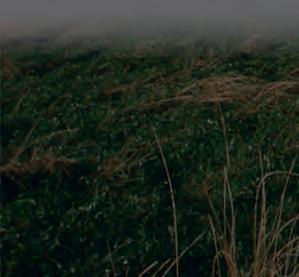

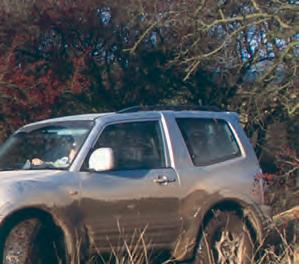


Turn left on Driffield Road, opposite the church in the village. As the road swings left at 4.45 miles, turn right for Pockthorpe
4
5.35 TA 048 629
Turn left on the track, just after a door in the wall on the right. Join the farm road ahead at 5.75 miles, then turn right on the road at 5.95 miles
5
6.85 TA 036 623
Turn right at the T-junction, then immediately left again on a track. It swings left at 7.55. At 8.05 miles join the road ahead at 1 o’clock.
68.85
Turn left at the T-junction. At 9.15 miles, turn left again for Driffield on a bigger road
7
913.85 SE 991 588
Cross a major road on to the track ahead. This one, too, is closed in winter. Turn right on to another track at 14.65 then, when you reach the crossroads at 15.2, take the road ahead
1015.95 SE 967 578
Take the track ahead when the road swings left. It turns back into a road at 16.75

10.75 TA 013 617
Turn right opposite the farm. Where the road swings right at 11.0, continue through the gate and over the field. Aim for the gap in the trees ahead, and you’ll pick up a set of tracks. At the crossroads at 11.75 miles, turn right
8
12.15 SE 995 614

Turn left on a wide track between hedges. Further on, it may be rutted in places; note that this track is closed from the start of November to the end of April

1117.35 SE 945 580
Take the track ahead when you reach the crossroads, then follow it as it swings hard right at 18.15. This one’s a little scratchy. At 18.75, you’re back on to tarmac
1219.15
Turn right at the T-junction, left on Joiners Lane and left again at another T-junction. You’ll then arrive at the Black Swan for the end of the route









































ROUTE Great Dalby to Sproxton 19.05 miles; 2-3 hours
OS MAPS Landranger 129 (Nottingham and Loughborough) Landranger 130 (Grantham)
NOTES

Mainly good, wide, well surfaced tracks, but some softer passages here and there which may have been rutted up by farm traffic. Allterrain tyres could therefore be useful in places when wet. You’re likely to see all sorts of other users, including walkers, horse riders and agricultural workers, but by far the biggest hazard is the speed of the traffic on the road liaison sections

• Before driving this route, or using any public rights of way in your 4x4, please read and pay attention to the notes on page 24

1
0.0 SK 742 057
Start outside the Royal Oak in Great Dalby. Zero your trip with the pub to your right; as the road swings right at 0.15, continue ahead on to Burrough End, then at 0.3 turn right for Burrough
2
0.75 SK 747 134
Turn left through a gate set a few yards back from a gap in the hedge and on to a track. After more gates, follow the tyre tracks across the field, then just after the buildings at 1.35 turn right at an angled T-junction with another track. You’ll be back on tarmac by about 1.45
31.65
Turn left at the road junction among the farm buildings, for Little Dalby and Pickwell. Left again at the T-junction on the outside of a corner at 3.25, this time for Little Dalby, then at 14.55 turn left at the crossroads for Melton on the A606
4
5.05 SK 777 158
Just before the road swings left, turn right on a track. Beware – this one’s hard to spot and you’re on a fast, busy road. The turning is just before three chevron signs for the bend, so
start slowing and signalling as you see them. A couple of car lengths in to the track, it swings hard right
55.1
Continue ahead through two sets of the double gates. After the second, follow the tyre tracks across the field, then swing left at about 5.4 miles – the ground is a bit rough here
66.2
At the crossroads with a road, continue ahead on the track. Turn left on another track at the next crossroads, at 6.6 miles, then turn right when you reach the road junction at 7.4
7
7.5 SK 771 174
As the road swings hard left, turn hard right on to the track between the farm buildings. This becomes a road after crossing a narrow bridge at 8.35 miles, then at 8.7 turn right at the T-junction with a bigger road
8
12.0 SK 820 199
As the road swings hard right, not long after entering Saxby village, turn left to go straight ahead on a no through road. It’s sign-
posted ‘Field Road’ at the junction; at about 12.1 miles, it becomes a track
913.1 SK 817 216
Turn right at the crossroads with another track, straight after the bottom of the dip. Continue ahead at the crossroads with a road at 13.65 miles, then turn right at the staggered crossroads with another track at 14.85
1015.65
Turn right at the crossroads with a road. Caution through the ford at 16.0 miles –it’s shallow, but the base is slippery
1116.1
Turn left at the main road, taking care as you emerge – traffic from the right will be on you in a flash. As the road swings hard right at 17.0, turn left for Sproxton and Saltby
121
7.45 SK 859 224
As the road swings right, carry on ahead on to the track. Turn right at the crossroads with a road at 18.05 (the road is barely visible as you approach). At 19.05, arrive at the Crown Inn in Sproxton for the end of the route









































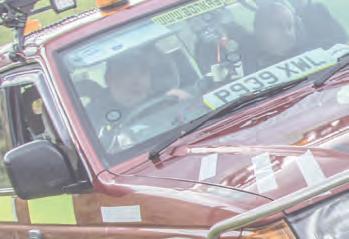






































1
0.0 SW 776 394
Start outside the Royal Oak, on Greenwith Road in Perranwell. Zero your trip with the pub to the left and set off heading north
20.05
As the road swings right, take the turning ahead for Greenwith Cross. At 0.3, turn left at the crossroads for Frogpool and Cusgarne
51.4 SW 756 399
Turn right after the houses, on a track signed Public Byway
61.85
Turn left when you reach the road the road, then right when you reach the T-junction. At 2.45 miles, turn right at the crossroads for Bissoe and Cusgarne
at Step 7 – if you find a byway called Poldice Lane, you’ve gone wrong
93.75
Turn left at the crossroads on a semi-surfaced track. When you reach the road at 3.95, turn tight right over your shoulder
104.45 SW 758 416


3
0.4 SW 772 397
As the road swings right, just before the 40mph signs, fork left on a track. Fork right at 0.45 miles for Barguss and Trewedna, then care over the small ford at 0.5 – the ground to either side will be sloshy after rain
40.55
Follow the track round to the left, then at 0.6 miles turn right at the T-junction with a narrow road. Turn left at the junction with a bigger road at 0.9
72.85 SW 753 409
Turn left over your shoulder on a track signed Public Byway. It’s tight and may need a shunt. Join a larger track at about 3.05, then at 3.25 the surface turns to tarmac and you emerge into the middle of a T-junction between two roads. Turn right, over your shoulder, on the first – not left then right on the main road
83.45 SW 751 412
Turn left on the track signed Public Byway. If you can’t find one, make sure you got it right
Just after the track on the left for Cusvey, there’s a junction with two tracks – turn left here. Follow the track until the junction at 4.85, where you kink left then right to take the road ahead. Continue on to the T-junction and turn right for Chacewater
115.05 SW 760 424
As the road swings left, carry on ahead on a semi-surfaced track. A little way on, bear right to skirt around a white house, then you’re back on tarmac. At about – which ends again at about 5.25 miles, the surfaced road swings


left into Hillside West Widden – as it does so, continue ahead on to a track
125.35
Opposite the big spoil heap on the right, there’s a hole to your left – which is also very big. It’s well hidden, too, and it appears just as you’ll be busy looking at the old mineshaft beyond it. Extreme caution required!

ROUTE Perranwell to Three Burrows 10.1 miles; 2-3 hours
OS MAPS Landranger 204 (Truro and Falmouth)
NOTES Easily driven in the main, but very awkward in a couple of places. This route should be suitable for a proper 4x4 on any tyres, though it will become slippery in places when wet. Even when you’re on the trails in Cornwall, you’re often very close to people’s homes, and some of the rights of way here are extremely popular with other users, particularly cyclists. Scratching and even panel damage are possible at one point, and ground clearance issues make Steps 11-15 ill-suited to soft-roaders.
• Before driving this route, or using any public rights of way in your 4x4, please read and pay attention to the notes on page 24
155.95
The fun continues courtesy of a particularly tight passage between two trees. It doesn’t look like much as you approach and even at first when you’re in it, but you might even have to slide round the one on the right. Meanwhile, a hole in the track will be leaning you in to the one on the left
188.45 SW 753 453
Turn right on a track opposite the ‘Single Track Road’ sign, between two very oddly placed national speed limit signs. You’ll soon come to a T-junction with another track; turn left here and follow ahead for just over half a mile, ignoring the track right for Gwynngala at 8.85


135.45
Turn left at the junction with a very small road, taking caution as you go – the chances of encountering cyclists out here are very high
14
5.65 SW 764 418
Turn left on the track and get ready for a long, loose, winding climb with dramatic views behind you. At 5.85 miles, turn right then immediately left, over a big axle-twisting hump, on to another track
166.25
Turn left at the T-junction with the road. Follow until you come to the crossroads at 7.75 miles then turn right then immediately left for Perranporth
178.15 SW 757 453
Turn left on a road with a Byway sign opposite, then left once again at the T-junction with a track at about 8.25 miles (the going does gets pretty tight here). This brings you out at a road junction at 8.35 miles, where you turn right
199.15
Turn left at the T-junction with another track. The surface gives way to tarmac at about 9.2 miles; just after this, turn left at the T-junction with a small road
209.3
Turn right at the T-junction. Stay on this road, crossing a dual-carriageway, then turn right when you get to a much bigger road at 9.75 miles. This comes out at a roundabout; turn right here and pull into the service area at about 10.1 miles for the end of the route


1
0.0 SU 254 537
Start outside the Shears Inn, on the junction of two yellow roads just east of Collingbourne Ducis. Zero your trip at the crossroads and set off heading more or less south, following the signs for Ludgershall and Andover
21.15 SU 248 521
At the road junction, continue ahead on to a track. Caution as you emerge – this is a major road. At 1.5, caution again as you cross another main road on to the track ahead –visibility is terrible, especially to your right. At 1.6 miles, as the track kinks right and then left, you’ll need to remove then replace a couple of electric cattle wires stretched across the right of way
31.9
Caution as you cross a Cat A Army track and continue ahead. Take the right fork at 2.15 miles, following the byway sign
42.35
Cross the road on to what at first looks like a driveway. You’ll see the track signposted to the right immediately after a row of houses. There’s a tricky off-camber side-slope just after you’ve turned, which needs to be taken very cautiously. Carry on across the narrow road at 2.7 and on to the track ahead
52.95

Turn slightly left, following the byway sign and ignoring the track dead ahead (we’d suggest staying out of the flood you’re likely to encounter as you turn…) At 3.2 miles, turn left on to the larger track that comes in over your shoulder
63.3
Slip out to the right on a track which heads up the hill towards a finger post at the junction with a Cat A Army track. Turn right here – it’s signed as a Permissive Byway. Stay on the Cat

A track until 4.1 miles, where it swings left; carry on ahead here, following the Byway sign. At 4.2, turn left at the bottom of the hill, again following the Byway sign, then at 4.3 rejoin the Cat A track, turning right but continuing straight ahead
74.6
As the main track starts to swing gently left, slip out to the right at about 1 o’clock, following the Byway sign. At 4.75, continue ahead over two crossroads in quick succession then take the left fork where the track splits
86.4
As the main track swings gently right, carry straight on on a very slightly smaller track. Turn right at the T-junction with the road at 6.65
96.9 SU 215 460
Turn right on the road for F Range. At 7.1, continue straight ahead after the red range

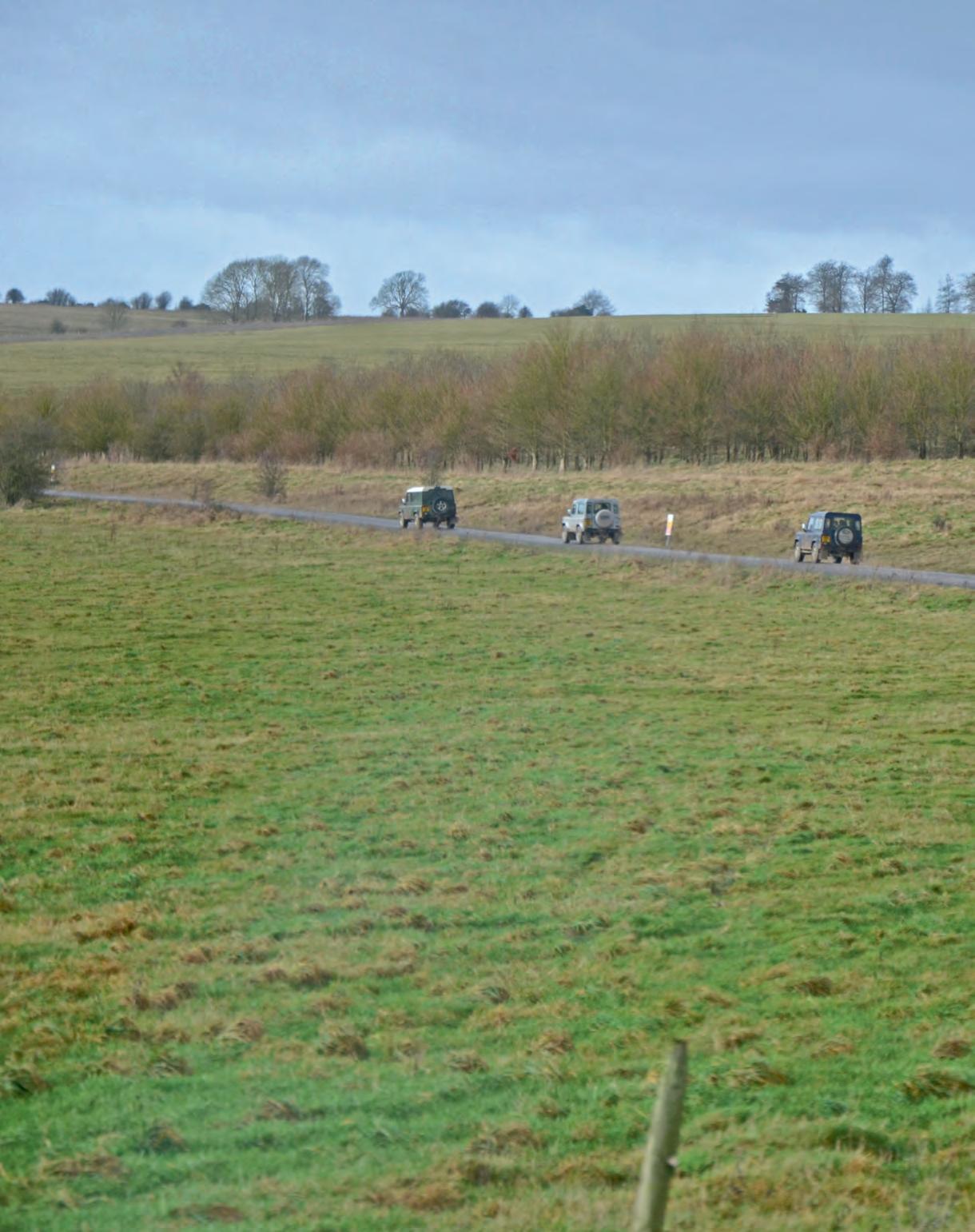
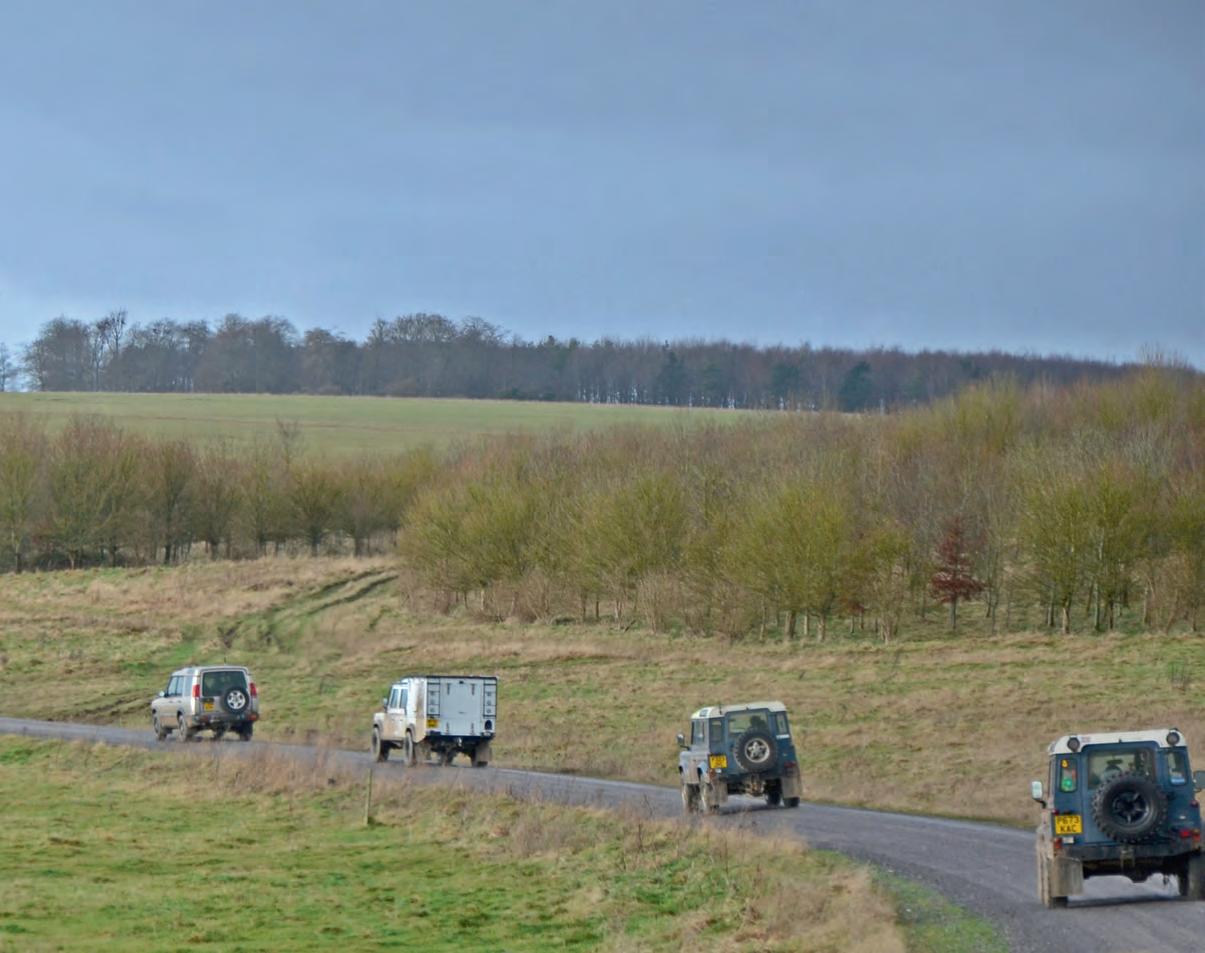
gates, assuming they’re open and the red flags aren’t up
107.6

ROUTE Collingbourne Ducis to Everleigh 17.1 miles; 3-4 hours
OS MAPS Landranger 184 (Salisbury and the Plain)
NOTES A particularly wide variety of tracks – many could be driven in a car, but there are some tricky ruts and technical sections too – as well as some potentially very deep water. Some of these rights of way are subject to red flags – if they’re flying, you must stay off – and others are permissory, carrying with them their own rules, so pay attention to the signs. Some scratching is possible and, while low box is not necessary, good ground clearance and all-terrain tyres certainly are
The track splits into two or three forks where people have tried to get round a section that’s prone to flooding. Stay on the proper right of way here, which is the one at about 1 o’clock. Just after this, continue ahead over a crossroads with another byway (look out for the signs), then at the second turn hard left back over your shoulder. This will take you on to the track you crossed a few yards previously – we’re navigating you this way to avoid damage to the wettest part of the junction. This track is quite rutted in places, and takes you close to scratchy undergrowth on the right 119.15
Continue straight on at the red range gate and flagpole. When you reach the road junction at 9.45, turn right

• Before driving this route, or using any public rights of way in your 4x4, please read and pay attention to the notes on page 24


129.6 SU 188 447
Just after the sign for a dangerous bend, and before the bend itself, turn right on the track signed as a byway. Start slowing and indicating well in advance for this one – and watch out for people coming round the bend towards you at warp speed. Get ready for some deep water at about 9.9 miles, and again as you dip through the trees at 10.1
1311.1
Turn right at the crossroads with another track. This one doesn’t have byway signs, but there’s a post to your left with red waymarkers on it. At 11.6 miles, turn left over your shoulder and back up the hill at an angled crossroads with another track
1412.25
Continue ahead over the crossroads. There are two tracks ahead of you; take the one on the left. At 12.35 miles, take the main



track ahead as a smaller one splits out to the left, then at 12.55 carry on over an angled crossroads and on to a slightly daunting looking set of ruts (which are actually quite tame)
1512.85
Turn right at the T-junction with a Cat A track, which is signed as a permissive byway. At 13.65, turn left at the crossroads, following the sign reading ‘Byway to Everleigh – Old Marlborough Road’
1616.2
Ignoring all the openings around you, follow the main track to the Stop sign at the road junction. Turn right at the road, which in effect means following it straight ahead
1716.9
Turn left at the T-junction with a bigger road. At about 17.1 miles, arrive at the Goa Balti on the left for the end of the route


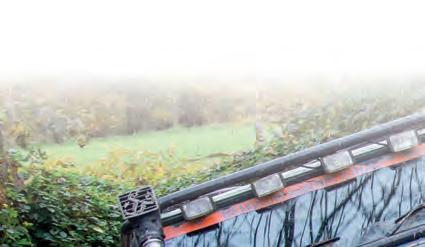




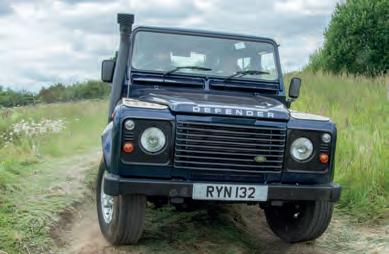












Land Rovers are returning to Stoneleigh this November for a day filled with Land Rovers!
Exhibitors old and new will join us, selling everything from parts & accessories to tyres, clothing and toys Talk to overland adventure specialists about your next trip, discuss modification options with companies with the know-how and other experienced Land Rover owners.



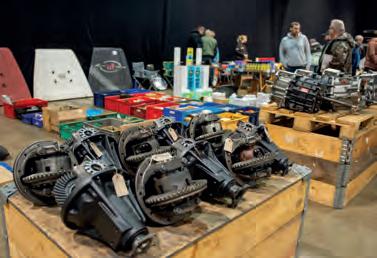



















A winning blend of eye appeal and subtle restraint, plus a deep dose of top-notch restoration by a leading 4x4 specialist, has turned this old Land Rover 110 into a wagon that’ll never get sand kicked in its face




















Bordeau is an unusual name for a Land Rover. Or for anything, really. At first glance, if you know anything at all about French geography (or wine), you might think it sounds like it’s missing the X-factor. Actually, it’s probably safe to say that noone’s missing the X Factor.
Anyway, as it turns out Bordeau is still a word, even when it doesn’t have an X on the end of it. It’s a type of leather, a species of sage that gardeners get excited about, the name of a company that makes rilettes and other healthy French delicacies and, on a slightly less exotic level, a surname. The 24,665th most common surname

in America, in fact, which is something I already knew and in no way did I Google it. And now it’s a Defender 110. First manufactured in 1988 and now manufactured again in 2025. That’s because Project Bordeau the latest piece of work to emerge from Legacy Overland, a company that doesn’t just tart up old 4x4s – it









remakes them from scratch, bringing them up to today’s standards as it goes and adding whatever luxuries and amenities its customers want. These are, needless to say, vehicles that are built to order.
‘Project Bordeau started with a clear vision,’ explains the company. ‘Transform a battle-worn 1988 Land Rover Defender

110 into a resilient and refined machine built to withstand the salty air of coastal life – without sacrificing comfort, character or craftsmanship.’
The salty air of coastal life has done for many a Land Rover down the years, so this is a taller order than it sounds. And it sounds tall. Sure enough, to quote Legacy

Overland, ‘the brief was simple in spirit but complex in execution.’
That brief was to build a Defender ‘that’s as tough as it is tailored.’ My old 90’s timing belt jumped a tooth during the night when it was parked up once, and similarly one of its CV joints disintegrated while I slept, and then of course there was that time where its




The cabin has been dressed to impress without being taken to ridiculous extremes. The highlight is clearly the diamond-quilted leather seats, which are trimmed in a mixture of black and Lexus beige, though the wood-rimmed Moto-Lita steering wheel is pretty eye-catching too
R380 gearbox did the R380 gearbox thing and I needed a whole new transmission. I would certainly have argued on those occasions that it was as tough as it was tailored, and it was about as tailored as a manky old plimsoll with a turd in it, but don’t let’s forget that this one has been manufactured all over again.

‘From a full drivetrain reseal to custom and “all-out” upholstery, a premium sound system and a full exterior repaint in Coniston Green gloss, every decision was made to balance beauty and durability. Inside and out, Bordeau is an expression of Legacy Overland’s signature approach – rugged elegance, with every detail
considered. Whether carving through dunes or parked in the shade of a dockside café, this Defender is ready.’
Quite a heroic claim, that. But this is a company that sets its standards high, whether it’s working on bringing an old







Range Rover back to life, coaxing the magic out of a 40-Series Land Cruiser or turning a proper old G-Wagen into the sort of Merc few shouty rappers would ever understand. It’s not just built to be a beach runner, this: it’s built to be the master of the sand.
You might be expecting a galvanised chassis to be writ large in the story, but in

fact the 110 is still on its original frame. It might have been battle-worn but it hadn’t suffered any mortal wounds or direct hits, so it was simply a case of cleaning it up and protecting it properly for battles yet to come.
Bolted on to it is something that ought to make you smile. So many poshed-up Defenders end up getting ridiculously over-

sized engines shoved under their bonnets, but this one is powered by the wonderfully simple, classic, Land Rover original 2.5 petrol. Not fast but it doesn’t need to be; the faster you go, the less time people have to see how cool you are.
The engine was fully rebuilt, of course, as were the gearbox and transfer case behind


it. Both were removed, stripped down on the bench and put back together again with new synchros, bearings, gaskets and fluids, and of course the rear main was done too while they were out. Same deal with the axles, with the diffs being rebuilt, as were the brakes. You can pretty up an old 90 or 110 while leaving it very ugly indeed beneath the surface, and we all know the sort of outfits who do that, but these guys do it properly. It’s not a ‘new’ Land Rover as such, but with everything about it being fully renewed –to modern standards, and indeed to high standards – it’s probably better than that.
It’s definitely posher than a new Defender ever was, with a custom interior featuring diamond-stitched beige and black leather on the seats and cubby lid. The same
beige (a Lexus colour) appears on the sun visors and a variety of dash inserts, where it contrasts with more of the black variety – it’s lavish but not overdone, with a sense of restraint that’s painfully absent on some of the treatments you see. Add in a woodrimmed Moto-Lita steering wheel, white faced gauges and billet ali knobs, pedals and switchgear and you’ve got a cabin that’s classy but not crass. Just the way a nice Defender should be.
There’s more to it than just the pretty stuff, too, though. The door seals have been upgraded to flush-fitting units that help reduce wind noise and increase insulation. That diamond leather has been applied to

So many of the remanufactured (or just tarted up) 90s and 110s you see have huge new V8s engines in them. It’s a nice idea but in practice we’ve always found them pretty horrible to drive. It could be said that the old 2.5 petrol is at the opposite end of the scale, but it’s original, it’s simple and it works. It’s one of the most reliable engines Land Rover has ever used, too
new seats with OEM-spec foam inserts. The speedo has been changed for one that shows the right speed. On a 110 of this age, it’s not abnormal for the needle to jive around all over the place, if it moves at all, but there’s none of that here.
There’s no shortage of electrical work that’s gone into it, too, not least for the hefty Marshall amp that’s mounted in the cubby box. The speaker facing on the front of the unit looks tremendously purposeful – a real statement of intent. The intent being to cruise along some sun-kissed seafront somewhere with the canvas rolled up, the Beach Boys cranked up to max and literally thousands of tanned lovelies in bikinis all throwing themselves at you.
And how could they fail to be attracted, when your Land Rover’s rolling on 265/70R17 Cooper Discoverer STT Pros and black steel modulars, rocking its glorious Coniston Green gloss finish and looking smooth with the all black grille, cage, sills, canvas and so on that very much give the impression of a guy who’s way too cool for chrome. Trying hard to impress is for people who, well, have to.
Now, you read this magazine because you’re interested in 4x4s and you’re interested in 4x4s because you like going places, not showing off on beaches. And it’s fairly obvious that even though this 110 comes across like it doesn’t have to try too hard, it does that because whoever commissioned it wanted everyone to know that they don’t, either. Personally, I’m imagining it with signal yellow paint instead of green and oxblood red leather instead of beige, which maybe says that I do have to


Left: It would almost look naked without a NAS step on the rear crossmember. The same can be said for the NAS lights, which have come to make the traditional style dome lights look very old-fashioned indeed
Right: Going in search of the cleanest possible look at the front end, Legacy Overland’s designers went for a bumper with no fog lights in it –just like they all used to be when the 110 was new
try too hard, but then there’s a reason why whoever put their money down for it could afford to do so and I can’t.
Besides, it’s just damn cool exactly the way it is. It makes me think of what a Wolf would look like in a James Bond tux, and
there’s not many things in the world that are cooler than that.
And besides, when the owner slides that billet ali transfer lever forward, knocks it to the left and lets those big Coopers claw their way over the sort of terrain only the coolest
vehicles in the world can dare to tackle, it’ll remind everyone who’s watching that for all the muted bling, it’s still absolutely the real thing too. It may sound like a fine wine with a letter knocked off the end, but this 110 is definitely not missing the X factor.











What could be greener than a car that’s into its fifth decade and still in regular use? Will Cowley’s Jeep CJ7 is much more than just a preserved classic, too – it’s a built-not-bought off-road warrior and an object lesson in the gentle art of recycling
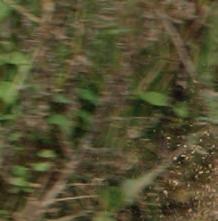






We hear a lot about recycling now. And quite right, too. In just a couple of hundred years, we’ve done a very good job of turning the planet into a bin – and assuming we don’t want to clog it completely with trash, we need to be making stuff go again as much as we possibly can.
Of course, in this wealth-obsessed world of ours, making stuff go again will always come a poor second to making money out of making stuff go again. That’s why making recyclable fridges, washing machines, houses, cars and so on will always win out over the old way of making fridges, washing machines, houses and cars that were






built to last, and not to need scrapping or recycling in the first place. But anyone who cares about the planet more than they care about having a second home in Florida will tell you that reusing things is always better than recycling them.
Which brings us to this Jeep. ‘This is real recycling,’ Will Cowley told us. ‘It’s got







to make more sense to build a car and keep it running than scrap it and keep buying a new one every couple of years, with all the raw materials and energy used in the process!’
If you take a look at his YouTube channel, you’ll see that Will has become something of a serial Jeep owner down


A well sorted interior carries everything from spare clothes to twin air compressors – necessary to achieve equal pressures at both ends of each axle, so that the Aussie Lockers will work correctly. Will prefers standard belts to harnesses, as they let him lean forward and watch where the tyres are going on the nadgery bits

You’ve got to love the combination of classic old-style simplicity and modern electronics, such as the 80-channel CB mounted in the bluff vertical dash

The CJ’s doors lift off for stripped down fun on the beach, so Will made up some lightweight tubular doors, skinned with cargo netting, to fit when the weather’s warm enough

the years. He’s had several of the things, all of them modified to one level or another; there’s been a TJ Wrangler and a couple of XJ Cherokees, and his current stable includes a lifted JKU, a Covid-special M38 hot rod and the vehicle you see here – a 1983 CJ7 which he’s owned since 2004 and modded from stock.
The Jeep carries spare water and fuel during its everyday life, but for off-road missions Will loads up with a pair of cargo boxes containing a home-made ground anchor, a kinetic rope, various strops, two snatch blocks, shackles and a Superwinch S4500 on a demount bracket with matched skid plate for the rear bumper

What you’re looking at is a snapshot of how the Jeep looked after Will had owned it for a bit more than half a decade. There’s no such thing as a finished project, as they say, but it was already a serious bit of kit – very much the sort of off-road toy you’d expect it to become in the hands of a man who’s spent his life working as an agricultural engineer.

This of course is a trade in which you need to know a bit about making stuff go again. Waste is a four-letter word in Will’s world – and crushing cars while they’ve still got life left in them is little short of criminal. Having grown up driving tractors on his parents’ farm and tagging along with his older brother on green laning trips, Will was always going to be a bit of a petrolhead,

Jeep’s AMC 258 4.2-litre straight-six has been fully rebuilt but not tinkered with. Running off a single carb, factory figures give it 112hp and 210lbf.ft, though in Will’s words, ‘with nearly 120,000 miles on it it’s not surprising if some of the ponies have run off!’ About the only mod he’s aware of is the aftermarket ali rocker cover which replaced the leaky plastic original. He’s added a manually controlled electric fan and some bonnet louvres to let hot air escape when the vehicle’s hard at work, but that’s about it. Behind the engine, the original TorqueFlite auto and Dana 300 transfer case remain, too; the former has a remote breather now, after it coughed all its oil out on the way home from a playday, but aside from regular oil changes after deep wading that’s all Will’s done to them
and as he started learning his trade it wasn’t long before he began modifying cars. ‘Most involved getting a larger engine from the scrapyard, rebuilding it with high performance cams and carbs and chasing about with my mates,’ he admits. ‘My best upgrade was a 1.3-litre Vauxhall Chevette to a 2.3 on twin carbs, with an upgraded axle, brakes, suspension, wheels and tyres.’

Left: One of Will’s earliest mods was the installation of an SAE 750 Ah tractor battery, which sits in a custom tray and runs heavy-duty cables to prevent power loss at the starter. ‘It gives me a massive store of energy to run the winch,’ he says. ‘Even though I’m running a standard 60-amp alternator, it has winched me out of trouble without the engine running after I got into deep water.’ Welder-spec cables for the rear winch run through conduit inside the vehicle, while there are dash-mounted winch controls and extra power sockets inside the cab for a compressor and hand-held lamp
Centre: Front axle is a Dana 30, whose casing is thick enough not to need any strengthening. The rear AMC20 unit, seen here, is thinner skinned, hence the addition of Will’s own rock guard to prevent damage while reversing. On the inside, both axles contain Aussie Lockers –automatic units which, at £150 each from America, were in Will’s words ‘a no-brainer.’ These date from when the axles were running their original 2.72:1 diff ratios, the idea being that they’d prevent shock loads by stopping the wheels from spinning when they lighten up over extreme terrain. When a halfshaft finally let go about a year later, Will replaced the original two-piece units with one-piece items imported direct from USA Alloy. A couple of trouble-free years, he wanted to go up to bigger tyres for all the usual reasons. The 2.72:1 diffs had been borderline on 31-inch rubber, but Will got a result in the shape of a 1979 CJ7 he bought for spares, with the same axles but a set of 4.1:1 units. ‘I spent a day or so on each to set them up and swap the Aussie Lockers over, but the job went smoothly and a year later they were working fine – and I was still using bits off the spare motor!’
Right: Old-school drum brakes tend not to be great in mud and water, which isn’t great when that’s where they spend most of their lives. Will reckons he went through a set of shoes every three days off-road, so it’s no surprise that he upgraded to discs. Front Suzuki units, which had the right bolt pattern to very nearly fit straight on, were paired with a set of calipers from a Rover 400, though Will does admit that these are on the limit of what they can do with 33-inch tyres

Various GTIs followed, before common sense prevailed and a 4.0-litre Wrangler came along. This was followed by an old Suzuki SJ, which possibly unsurprisingly didn’t have enough grunt for his tastes, before he went back to Jeep and got himself a diesel Cherokee. ‘It was a perfect all-round car for getting about, green laning, camping trips, towing a dinghy and so on. It was also very good off-road, so I lifted it a bit and added 31-inch MTs and fabricated a front winch bumper, side rails and some underbody protection. That made it better still, and I started to do more serious stuff with it. Trouble was it was just too good and expensive a car to ruin.’
His answer? You’re looking at it: a 1983 CJ7 with a 4.2-litre six-pot and auto box, which he bought with an alloy rocker cover and +2.0” lift springs and dampers already in place. ‘It’s an off-road icon,’ he says. ‘You’ve just got to admire the longevity and pedigree of the breed. Also, it’s easy to work on, body

Above: You know what you’re getting with an old CJ7; strength, simplicity and… rust. The whole of the rear chassis and crossmember was fit only to be axed off, and Will wanted to replace the latter with a stouter item for recovery work anyway. This is what he came up with – a strongerthan-original unit which is tied into the back chassis with extra plates of steel to take the strain of heavy snatches
Right: Something else a good back bumper should protect is your departure angle. Job done there: there’s an almost straight line down from the back of the body through the rear spring hanger to the tyre’s contact patch
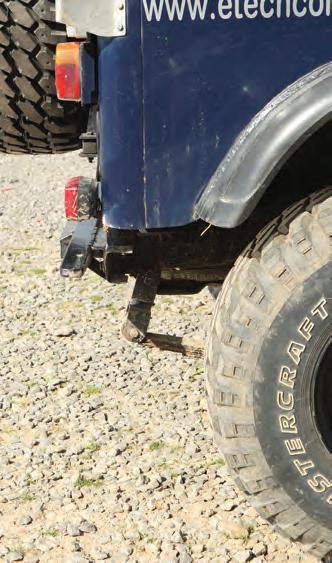

wise and mechanically, and has decent engine power. I fancied trying an auto, too –I could see many benefits of the smoother power application.’
That was five years before we took these photos, and the project progressed steadily over the period that followed. Unlike most people who start a project, determined that a month from now it will emerge from the workshop transformed into the greatest thing the world has ever seen, his strategy was to try and do one major mod each year. He didn’t waste any time getting it on to bigger tyres, but additions like a new starter,


bigger battery and fuel lift pump were more about reliability than performance. Later on, he fitted Aussie Lockers, converted the body to a truck-cab with a chequer plated storage compartment, converted the back axle to Suzuki disc brakes and Rover 400 calipers and swapped out the original diffs for higher-ratio units to cope with taller tyres.
Of all these, he rates the ‘brilliant’ Aussie Lockers as the best bought-in mod and the truck-cab conversion as the best home-brew. ‘It has improved visibility and access round the vehicle when in awkward situations, and it gives me all that rear
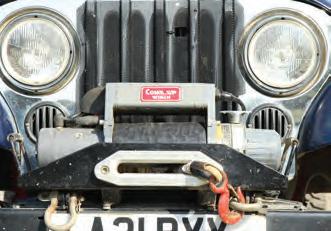
Far left: Will’s changed the Jeep’s tyre size twice, from 29” to 31” and on to 33x12.50R15s. Even with the extra height in the springs, he still needed to lift the body by 60mm (a touch less than 2.5”) to make room for the taller meat. This was a simple case of chopping up some polyurethane rod, drilling each length down the middle and using them as spacers between the chassis and body. The brake and fuel lines had more than enough flex in them to cope
Left: Will bought the vehicle with the +2” springs it still uses now, but he’s gained an extra inch by using home-made hangers and liberated some extra flex with his own anti-roll bar disconnects. Future plans when we spoke to him included fitting longer shocks and adding a Z-link arrangement to let the springs dislocate. In the meantime, he cleaned up the shape of the U-bolts to reduce the likelihood of them snagging
storage space.’ Not that he’s unhappy with anything he’s fitted: ‘I considered the pros and cons of everything first, either proven on previous builds or observed on other vehicles.’
Something he didn’t need to observe anywhere else was that before he thought about improving the Jeep, first he needed to bring it back from the brink. The CJ7 is well known for its ability to resist rusting, said nobody ever.
‘When I got the vehicle,’ Will told us, ‘the rear chassis crossmember and rails were a bit ripe. As a known weak point for recovery
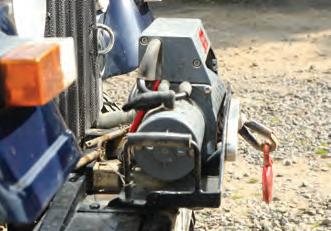
Left: The multiple receivers Will designed in can be seen here. These allow the bumper to accept a 50mm ball hitch, a demountable winch (he has two, a Come-Up 9000i and a Superwinch 4500) or the toe of a high-lift jack, in whatever position is most suitable for the recovery in hand. Note also the fuel tank guard; this protects a 1979 CJ unit, which at 50 litres is smaller than the original while still containing enough gas for a day’s green laning or a weekend at a playday site. Its size meant that after lifting the vehicle’s body, Will could mount it higher in the chassis, tucking it up higher and further away from expensive rocks
Centre: Will doesn’t do as much winching as he used to in the days before he got his Aussie Lockers, but the Come-Up 9000i still sees plenty of action. It’s spooled with Dyneema Bowrope, which is his first choice for safety – no small matter when most of the time it’s being operated by his wife. Interestingly, he’s found that the alloy hawse fairlead tends to get damaged by the rope when pulling at tight angles: ‘after a while, the rope cuts in and makes a sharp edge which I have to keep re-profiling with a die grinder. I blame it for snapping the rope a couple of times – not my fault for getting stuck, obviously!’
Right: The winch mount looks unusual, but it’s been carefully thought through to provide maximum strength without sacrificing flexibility. Tied into the standard quarter-inch U-channel bumper, it’s bolted right through to the chassis to create an integral crossmember


Left: Tied to the underside of the bumper is a custom steering guard. This is asymmetric in shape, protecting the vulnerably positioned PAS box while doing the least possible amount of damage to the vehicle’s approach angle
Right: Owning the Jeep has been a never-ending story of trying to fight off the dreaded tin worm, so it’s no great surprise that the original sills are long gone. Will cut them away and welded in full-length rock-sliders which he made up from 40mm box with profiled ends. Tubular nerf bars provide added protection when it’s trees rather than rocks that he’s worrying about: ‘these create real side impact protection where there really was none, until you got to the chassis rails, about mid-way on the seats!’
work anyway, I cut out the rusty steel and replaced it with a stronger than original crossmember, repaired the rear rails and added extra steel along the length to tie it all in. I then added a custom-built multi
receiver rear bumper for winch mounting and recovery points.
‘Over the time I have had it, I’ve worked through various old bodywork repairs and some newer rust areas. I’m probably about
90% through, but like painting the Forth Bridge I will be starting again eventually!’ When they say there’s no such thing as a finished project, that’s not normally what they mean…
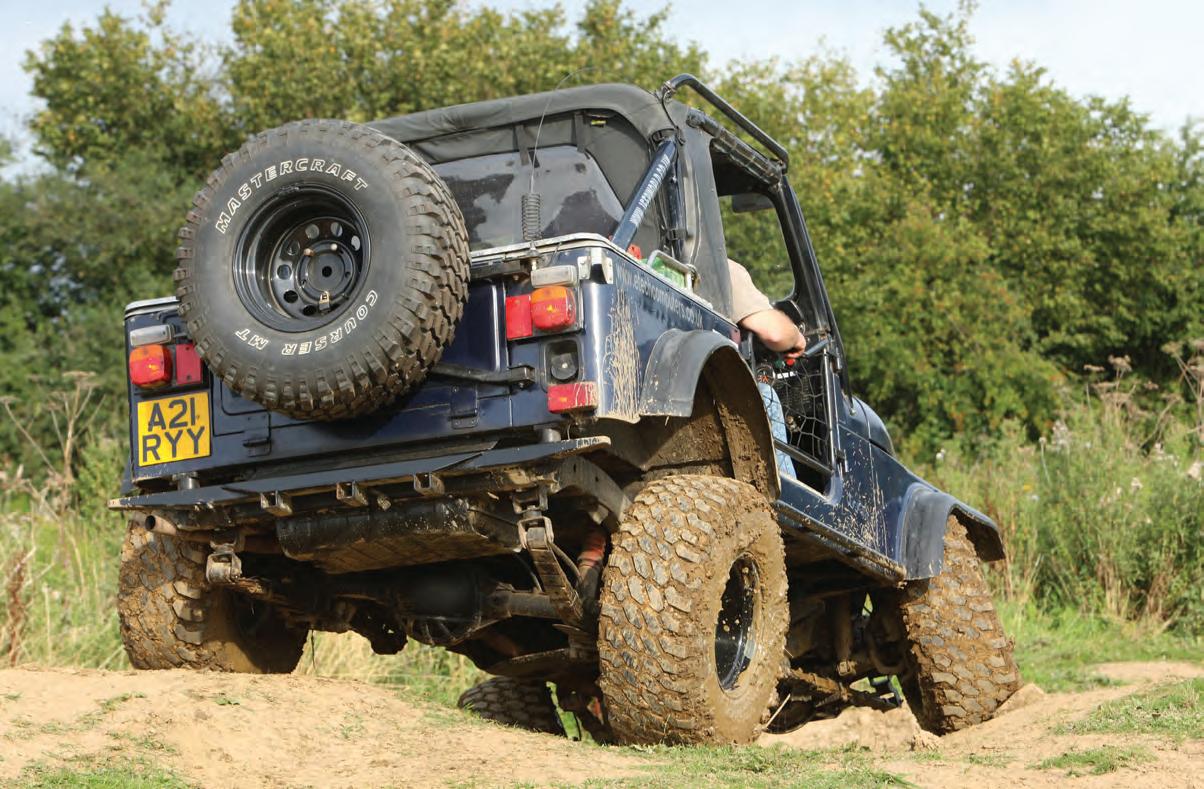




Words: Jurij Modic Pictures: Jurij and Mateja Modic
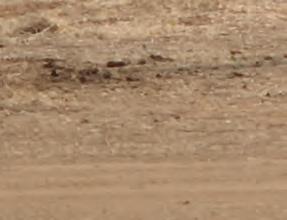
In last month’s issue, we told the story of our travels through parts of Zimbabwe which are steeped in the nation’s history. We visited the sprawling remains of Great Zimbabwe, a stone city built between the 11th and 15th Centuries which is now the largest pre-colonial site in all of Africa, and Gonarezhou National Park – where the last couple of decades have seen new management strategies work wonders to rehabilitate a wildlife population traumatised by decades of war and poaching. We watched the sun set from the Chilojo Cliffs, forded the bonnet-deep Save river, were serenaded by the roar of lions at a wilderness campsite, saw 2000

Continuing their exploration of Zimbabwe’s history and wildlife, our travellers head for one of Africa’s largest national parks, finding themselves amid a giant post-industrial wasteland and then witnessing one of the greatest sights Africa has to offer
year old wall paintings in Nswatugi Cave and fled a relentless swarm of mopane flies in Matobo.
And our expedition was still only halfway through!
We had rented a fully expedition-ready Toyota Hilux 2.4 Bush Camper from Bushlore in South Africa, a company we’ve used a few times previously. The vehicle had a spacious roof tent integrated within its canopy which was easy to set up and climb into, along with a fully equipped kitchen, dual batteries and solar panels, a 40-litre water tank and twin fuel tanks, giving it a range of more than 1000km. It was delivered to us at Harare airport and collected again afterwards, all for a very

reasonable price, and everything about it really was ideal.
The second leg of the trip started in Hwange National Park, which at more than 3.5 million acres is the largest in Zimbabwe. We hadn’t made any reservations in the camp sites, as we knew there would always be plenty of space at Main Camp and Sinamantela, but we were hoping that maybe we would get space at some of the premium campsites.
These are too expensive to book in advance, if you are a single traveller or a couple, as they are charged per site. If they are unoccupied when you arrive, however, you can get them from the office in Main Camp or Sinamantela at a special ‘walk-in’



rate. We were lucky when we enquired at the Main Camp: we could get Ngweshla, Jambili and Masuma for the next three nights at the much more affordable rate. We couldn’t be happier – though we decided to stay put in Main Camp for that first night, as we were too tired to move anywhere further.
We had Main Camp to ourselves when we arrived, which didn’t make it any less bleak. It’s okay for a night but we were very glad to be fixed up with better sites for the rest of our stay in Hwange. Still, the staff gave us free firewood, which made up for the barely functional washing facilities. Later in the afternoon, we took a drive out to the wildlife viewing hide at

Nyamadhlovu Pan. It was very quiet but one of the safari guides there gave us a tip about three lionesses and their cubs, who were feasting on a young elephant carcass only a few kilometres away on the road toward Jambili.
Following his instructions, we found them easily. They were lying in the middle of the road with the elephant a few meters away in the thicket. We stayed with them until the last sunbeams, with only two other cars present.
Our reservation the next day was for Ngweshla. This is located in the southeast of the park and the 60-kilometre transfer there, past Mkwa Pan and Kennedy Pan, was a game drive on its own.

Ngweshla campsite is very well looked after and has a wonderful setting near a waterhole, under huge trees. It also serves as a picnic site, so daily visitors can use its facilities during the daytime, but during the night you are guaranteed it to yourself. We liked it very much. Wildlife is in abundance and we covered most of the nearby loops in the afternoon and the next morning. In the evening, we found two male lions dozing in the grass not far from the road. Ngweshla would certainly be our campsite of choice in the eastern part of the park. It wasn’t far to our next site, Jambili, so the next day we took it very easy indeed. The track goes past three lovely waterholes, the first of which was full of

How long does a meal last when you’re a lion? The authors found these three lionesses, accompanied by three cubs, feasting on the carcass of a young elephant on the road to Jambili. They passed the same spot three days later – and the party was still going on
zebras – with a bull elephant and a jackal standing guard. The site is tucked away in the forest, a little further away from Jambili Pan. It doesn’t have any view and the ground surface is deep sand but regardless of that, we enjoyed its solitude very much.
The following day’s drive, by contrast, certainly was a long one of around 110 kilometres to Masuma Dam, so we were up early to set off at first light. We drove past the lovely Dopi Pan and, just before reaching Nyamadhlovu hide, passed the spot where we saw the lions three days ago. And guess what? They were still there! They had moved from the road into the thicket, where the unfortunate young elephant was, but clearly they weren’t finished with it yet.
We passed Nyamadhlovu, Guvalal and Shumba game viewing platforms en route to Masuma Dam. Apart from the daily visitors, we were supposed to have the site to ourselves during the night, however when we arrived there was already a Dutch family there. They had been camping there for the last two nights, and supposedly had booked for the next night also; it might have been a double booking, I suppose, but I didn’t exactly check their reservation papers. They were nice companions in the camp and the site, which has a wonderful hide, doesn’t really feel too intimate anyway, so we didn’t care much about solitude. The camp attendant, a man called Adi (short for Adorable), was very devoted and proud of the place, and so he should be as he took excellent care of it.
The hide above the Masuma Dam offers an exceptional point for viewing the very


busy waterhole. Apart from the resident pod of hippos and a few crocodiles, it was frequently visited by impalas, kudus, giraffes and other animals – including endless herds of elephants. The day before, there had been an official game count at the dam and apparently they counted around 650 different elephants visiting the waterhole! We spent the whole afternoon and part of the night – it was a full moon – in the hide, observing the wonders nature had provided for us.
Ten years ago, we had had to cut short an expedition in Hwange when our daughter fell ill, meaning we only had two full days in the park. That was enough to show us how much we liked it, however. And this time, after five days’ stay, we had fallen in love. We left for our next stop, Chizarira, knowing that we would return one day.
It’s quite a long way to Chizarira, so despite our nocturnal game viewing we started quite early from Masuma, passing Mandavu Dam on the way to Sinamantela, where we checked out of the park. Soon afterwards, we encountered a pack of wild dogs crossing our path – a magical moment of the sort Africa provides with an unmatched largesse, even if it all happened
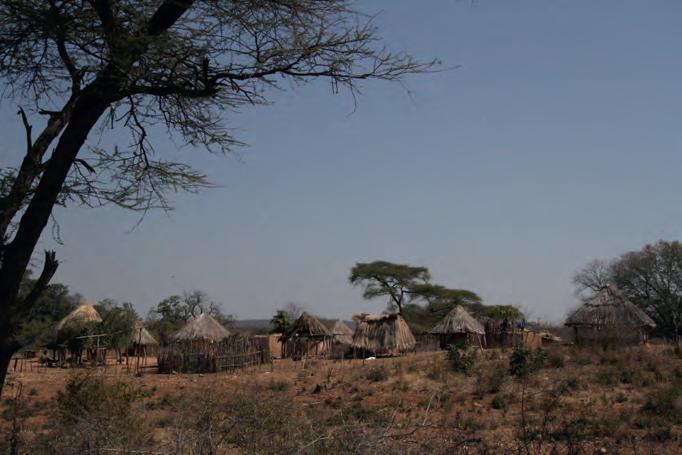
too quickly for us to grab our cameras. Sometimes it’s best just to look on in awe.
After leaving the park, the road to Hwange itself crosses a landscape which has been totally devastated by a huge opencast coal mine. When it comes to mining, Hwange is best known for the disaster that occurred in 1972 when an underground explosion killed 427 people. Travelling through a ghostly wasteland that feels like something from a sci-fi movie, it’s hard not to conclude that a different kind of disaster has happened here too. Quite a shock, especially after being in the nearby pristine wilderness for almost a week.
Stopping off in Hwange, we topped our fuel tanks to the brim and refilled an empty gas bottle. Then, without any further lingering, we drove down the A8 to the turnoff for Mlibizi and Binga.
As soon as we turned off the main highway, there were no more heavy trucks or any other traffic – we had the road all to ourselves. And it is a very good tar road which passes through scenic landscapes. Homesteads and villages built by the Tonga people are dotted along the road, with typical thatched houses and huts.
After the turning for Binga, an excellent tar road becomes a good gravel road which still allows reasonably fast travel. On the way, we supplied ourselves with firewood from one of the many stalls along the road. About five hours after setting out from Hwange, we reached the turning for Chizarira National Park. And now the good roads and tracks were history: the route to the park gate and on to the main park office becomes a serious 4x4 trail.
You don’t visit Chizarira for wildlife. You come here for the scenery, which really is just incredible – so different from anything we had encountered on the trip so far. Even the birdlife wasn’t prolific.
We had been hoping to get a pitch at either the Mucheni View or Mucheni Gorge camp sites, but at the park gate we were told they were occupied. This was disappointing, as those were the ones we were hoping for; we had been expecting the Chizarira park to be more or less empty, but it was looking like we used up all our luck in Hwange. Happily, though, when we got to the main office, it turned out that only the Mucheni View was occupied, while Mucheni Gorge was available.
Mucheni Gorge is situated on the very edge of a precipice at the side of the deep gorge. The views are magnificent. We also visited Mucheni View, where the campsite
was occupied by a young Swiss couple on a longer tour of Southern Africa. Both of these two camp sites are just wonderful; if you’re visiting Chizarira, grab whichever of the two is available!
Truth be told, we certainly didn’t do the park justice by spending less than a day there. We only used it as an overnight stop between Hwange and Kariba – and it deserves better. Next time, I think three to four full days will be in order.
So with our overnighting done, the following morning we backtracked down the escarpment to the Binga-Karoi road and continued to follow it east. The gravel surface became worse and the travelling became really slow and tiresome until, done with the bad road, we decided to follow it all the way to Karoi in the hope that instead of taking the escarpment (‘powerline’) shortcut directly to Kariba, we would find that the new tarred road from Karoi had made progress to the west.
We refilled our diesel tanks and did our shopping for the next week in Karoi before pressing on to Kariba. Having started out from Chizarira at around 7.30am and driven more or less non-stop all day, we made it to Warthogs camp in Kariba at around 4.30. We had stayed there on our first visit, ten years previously; oddly, the site itself had moved a few hundred metres, and they now favour pre-erected tents and chalets over leaving space for campers, but it still has an overlanding vibe and the dinner we had at the restaurant was very good and decently priced.
By now, we had been travelling for two weeks without ever spending two consecutive nights in the same place. It was by choice, but it’s a tiring way to see the world: even full-time expedition


travellers who live on the road tend to linger for a few days when they find places where they feel at home. So to unwind at the end of the trip, we planned to spend five nights in Mana Pools. This is the kind of environment we like the most: breathtaking scenery on the banks of one of the African most majestic rivers, with the abundance of wildlife around us.
Nyamepi, the headquarters of this UNESCO World Heritage national park with its public campsite on the banks of the Zambezi, was just the right spot for that. And we couldn’t have chosen better. Mana Pools probably ranks among the top five or 10 national parks in Africa; we already had marvellous memories of it from our first visit and now our impressions of it are even more enthusiastic. Its wilderness and tranquillity are hard to describe.
We registered at Morongora park office and then descended down the Zambezi escarpment, on a road where we surprisingly met almost no heavily loaded trucks. Immediately after the first boom into the park, just off from the main road, we deflated the Hilux’s tyres to cope with the insane corrugations on the gravel road; these did eventually became slightly better, especially after we passed the grader that was working its way out of the park.
Registering at the main park office at Nyamepi, I casually asked if they had any free pitches at Chitake Springs during the

next few days. To my immense surprise, the answer was that yes, there was a free spot there on our last day in the park.
Chitake Springs is positioned more inland from the Zambezi river, where water is very scarce. A perennial spring in the Chitake riverbed offers an isolated source of water for the whole region, so all the animals from that area gravitate to that spot. This of course guarantees a wildlife hotspot during the drier months. However there are only a handful of camp sites there and they tend to be booked a long time in advance, so I was over the moon to get one.
As it was, our pitch in Nyamepi itself was just perfect, with ample shade during the day and an unobstructed view over the Zambezi. Surprisingly, there were only a handful of other campers around for the first couple of days – though among them were Jenny and Andrew from Stuck in Low Gear, who we know from the South African 4x4 Forum but had never met in person. I recognised their Land Cruiser straight away on the campsite adjacent to ours; it was like meeting old friends, and chatting with them around the campfire
The roads into and out of Mana Pools National Park are wide and firm, but they’re also apt to be horrendously corrugated. Time to air down – something that proved necessary anyway on some of the terrain that was to come
made for a wonderful evening under the bright African stars.
Our stay in Mana was a leisurely one. We did morning and evening game drives each day, covering all the tracks between Mana Mouth and Rukomenchi, but apart from that we spent our time relaxing in the camp – and still always surrounded by animals. Herd of impalas were often at the edge of the site, while baboons, monkeys, warthogs and elephants were not so shy – they could always be found somewhere inside the camp. The elephants were very relaxed, strolling between the pitches as if there were no people, cars, tents, and trailers as they searched for juicy branches to knock from the trees and chew.
One morning, when we were preparing to set off for a game drive, one of the camp’s attendants pointed out a pride of lions within the perimeter of the site, resting under the trees merely a hundred meters from our pitch! They were eagerly monitoring a herd of buffaloes nearby. Without that hint, we would probably have driven past and never noticed them.

There are many camp sites in Africa, but not many of them can match the utterly tranquil setting of Mana Pools. The site itself is glorious – as is the experience of watching the sun rise behind the giant baobab forest overlooking the Chitake

Another morning, we hired a park ranger to take us on a game walk. Walking in the true African wilderness is always a special experience – and after being in the car for almost three weeks, it felt so good to properly stretch our legs.
We met Jenny and Andrew again on the drive to Chitake Springs, where they had spent the three nights after our meeting while we were chilling in Nyamepi. They were ecstatic about it, which of course only raised our excitement.
Knowing how wild this corner of Africa really is, we arranged for a park ranger to escort us during our stay there. And it was just as well, because just finding the camp site was tricky – there is absolutely no signage and without a GPS and a good map, we could easily have driven right past it and got lost in the wilderness.
When we finally found our pitch, it was just a small clearing in the bush, in deep sand, right next to the dry riverbed. From
there, we could clearly see the springs, about 300 metres upstream of the riverbed with a large herd of impalas and kudus.
We were sharing our ranger, whose name was Marvellous, with a group of young South Africans staying at the adjacent pitch, and at 3pm we drove a couple of kilometres along the northern side of the riverbed before setting out on foot. Marvellous had spotted a pride of lions on the other bank that morning, and sure enough we soon found them dozing under some trees.
We continued walking upstream on the northern side of the riverbed until we found a suitable place to descend into the Chitake river canyon. Marvellous was an amazing guide, all the time explaining the flora and fauna around us, and the South African guys with us were very pleasant company – though the afternoon air was still very hot and the sun was scorching, so it was quite a tough trek.
The Chitake riverbed here is actually a canyon with vertical rock banks. Being totally dry, one can only imagine what an immense volume of water must rush down there during the wet season to carve such a deep scar in the limestone terrain.
We walked quite a long way down the riverbed until we came to a place where we could climb out of it to the northern bank, close to where we left our trucks. We were all exhausted but thrilled with the experience. In the last light of the setting sun, we could see that the lions were still there, two up on the other bank and two down on the riverbed, totally uninterested in a group of elephants who were coming upstream to quench their thirst.
The evening at our small campsite, tucked away in a dense bush by the riverbed, was tense. We lit a small fire but the lions’ roars and elephants’ trumpeting, the suspicious


sounds from the bush close by and the shining eyes of hyenas around our camp soon chased us to the relative safety of our roof tent.
Early the next morning, we all gathered again to witness the rising sun at the baobab forest above the Chitake. We crossed the river in our cars (the entrance and exit from its dry bed were quite serious, certainly needing low range), and drove to the group of baobab trees a few kilometres up the river. There’s a camp site here but by good fortune it was unoccupied, so we had the place all to ourselves – and the spectacle of the rising sun behind the giant trees was incredible. After this, there was time for another game walk before we had to move on. But it was what happened after this that we’ll remember most. Marvellous led us to a

point overlooking the springs, where we could set up our camp chairs in the shade of a huge fig tree and wait. He knew what was coming – and sure enough, after about half an hour we spotted a herd of about 200 nervous buffaloes in the thicket
behind our backs. They were carefully looking down to the springs, checking to see if there are any lions down there. When the first few buffaloes couldn’t control their thirst anymore and started their descent down the bank, the whole

Left: The experience of witnessing a herd of around 200 buffaloes stampeding down to the water to drink was breathtaking. You can just about hear them in this picture
Right: One thing the authors didn’t hear was the pride of lions that took up residence about 100 metres from where they were camped. Having that one pointed out by a ranger must have been quite breathtaking too

herd immediately followed them in a thunderous and very dusty stampede. It was an incredible sight to behold. Once down on the riverbed, they nervously ran to the springs and started drinking, all the time scanning the banks and the riverbed for lions. Luckily, for them at least, there were none to be seen – and after a very short drinking session, the whole herd climbed out of the riverbed on the opposite bank. It was over quickly – but this must rank as one of the most exciting wildlife encounters in all of our African ramblings. A perfect climax to our three weeks in Zimbabwe, and confirmation that Chitake Springs really is as good a destination as we had expected!
Leaving Mana Pools with some very fond memories indeed, we took the road from the Nyakasikana Gate – which seemed slightly less corrugated than on our way in. We aired our tyres back up at the Marongora office then refilled our fuel tanks at Karoi before continuing south. We
were delayed for an hour at the scene of a crash on the main A1, where the road was blocked by three trucks, but soon enough we reached Chinhoyi Caves, a small national park about 130 kilometres north of Harare which seemed like an ideal spot for our final night.
We arrived early in the afternoon and were somewhat shocked to find long queues of visitors in front of the park’s ticket office. However it was Saturday, and Chinhoyi Caves is obviously a very popular attraction and picnic venue for locals. Thankfully, the camp site is separated from the picnic area and we had our pick of the pitches – and better still, the toilet and shower block, which is reserved for campers only, was brand new, spotlessly clean and with hot water.
The queues for visiting the caves were way too long, so we decided to visit them in the morning instead. A good call, because we then had them all to ourselves. The caves are quite deep, with steep
climbs both down into them and back up again, but the paths are well enough paved and electrically lit where necessary – and it’s worth the effort, because the pools of water at the bottom are stunning in their cobalt blue colour.
It was maybe a bit of a touristy way to end our three weeks in Zimbabwe, and hard to believe that just 24 hours previously we had been sat watching that herd of buffalo stampeding down to Chitake Springs. But of course the closer you get to the airport, the further you get from the wilderness. The rest of our journey back to Harare was uneventful, as was handing the Hilux back to the driver from Bushlore who arrived to collect it. A smooth ending to a smooth trip that had gone exactly as planned – and very much rekindled our love for Zimbabwe.

The authors, who are regular travellers in Africa, document their visits there in a Wordpress blog titled Our African Ramblings. You can find it by visiting safaribug.wordpress.com




A celebration of Solihull’s finest – including this superb Discovery 2, fresh from a resto-modding programme on the far side of the Atlantic

First drive of the all-new GWM Poer300 pick-up
Global travel in the modern breed of Land Rover
New chassis and new life for an early Defender














• Escape Gear
• ...and many more!


• Aluminium canopies
• Roof tents and roof racks



• Off-road fridges and 12v gear
• Drawer systems and slides















• Bumpers, side steps and vehicle protection
• Campsite essentials, tables and chairs



